Sage green offers a timeless and calming foundation for a dining room, creating a space that feels both sophisticated and inviting. This versatile, earthy hue bridges the gap between neutral and color, providing a serene backdrop for everything from casual family meals to formal dinner parties. Its connection to nature promotes a sense of tranquility, making the dining experience more relaxing and enjoyable. Whether used as a dominant wall color, an accent, or through furnishings and decor, sage green can adapt to a wide range of styles, from modern farmhouse to minimalist and traditional designs, ensuring a beautiful and harmonious result.
1. All-Over Sage Green Walls
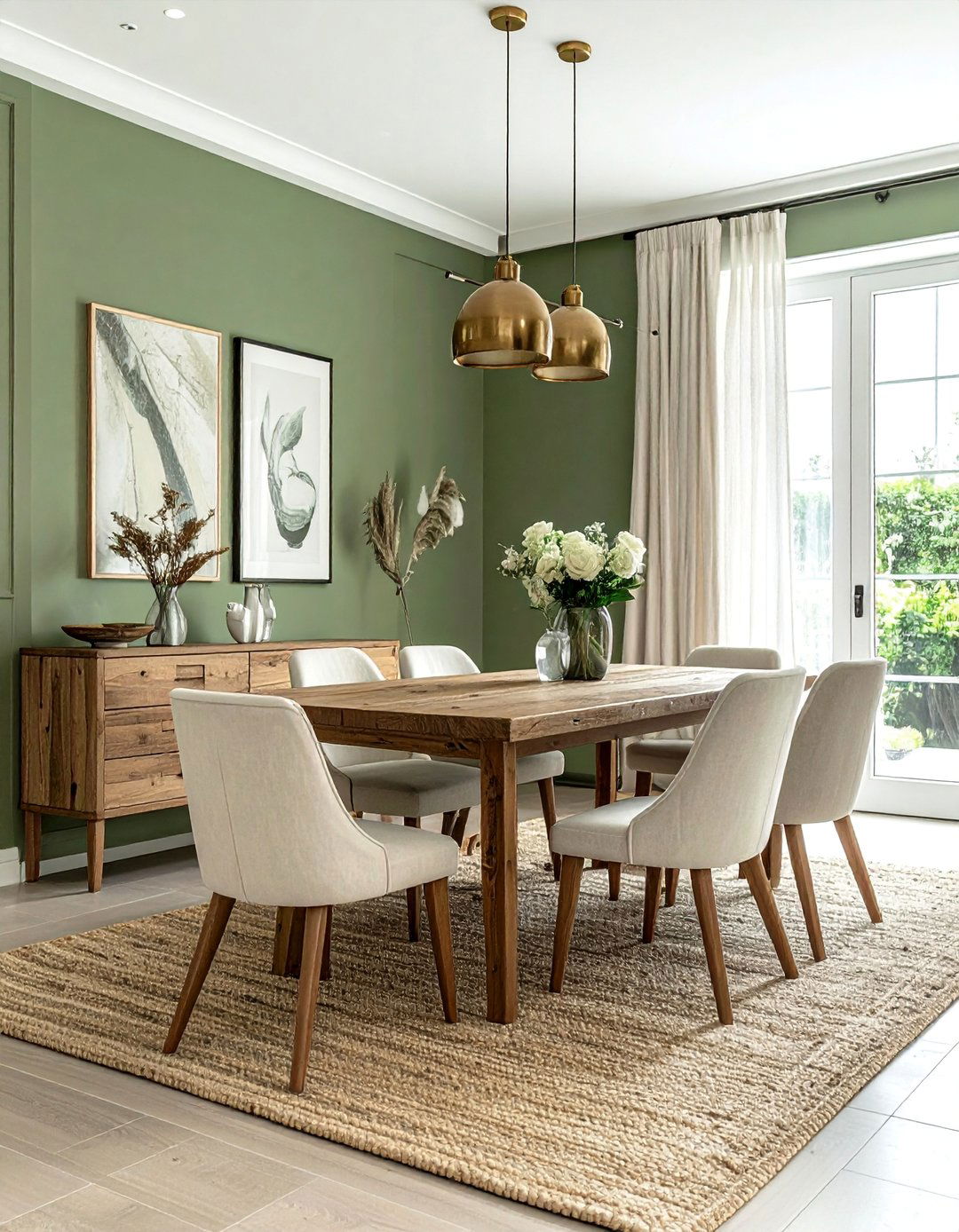
Painting all four walls in sage green creates an immersive and deeply calming dining environment. This approach cocoons the space in a soft, earthy tone, establishing an immediate sense of tranquility and cohesion. To prevent the room from feeling too monotonous, introduce textural variety through a rustic wooden dining table, upholstered chairs in a neutral fabric like linen or cream bouclé, and a woven jute rug. This layering of textures adds depth and interest while maintaining the serene atmosphere. The monochromatic backdrop also makes it an excellent canvas for metallic accents, such as a brass chandelier or black metal-framed artwork, which pop against the muted green.
2. Sage Green Accent Wall with Board and Batten
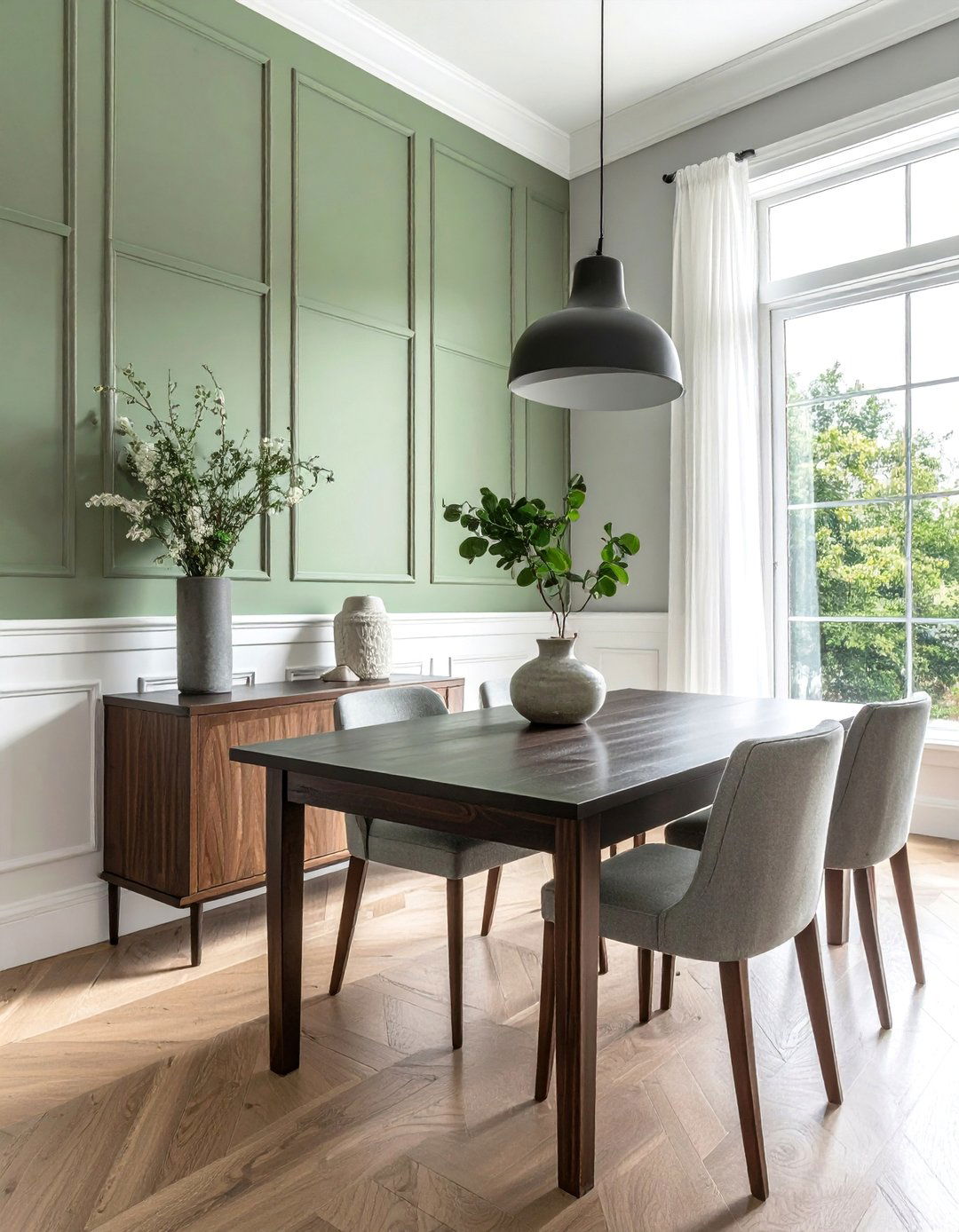
For a touch of architectural interest, a sage green accent wall featuring board and batten detailing is a superb choice. This design element adds texture and dimension, elevating the dining room beyond a simple coat of paint. Placing the feature wall behind the main dining table or a sideboard creates a natural focal point that draws the eye. The clean lines of the woodwork pair beautifully with farmhouse, transitional, and coastal styles. To complete the look, paint the remaining walls a crisp white or a soft off-white to keep the space feeling bright and airy, allowing the sage green feature to stand out without overwhelming the room.
3. Sage Green and Natural Wood Tones
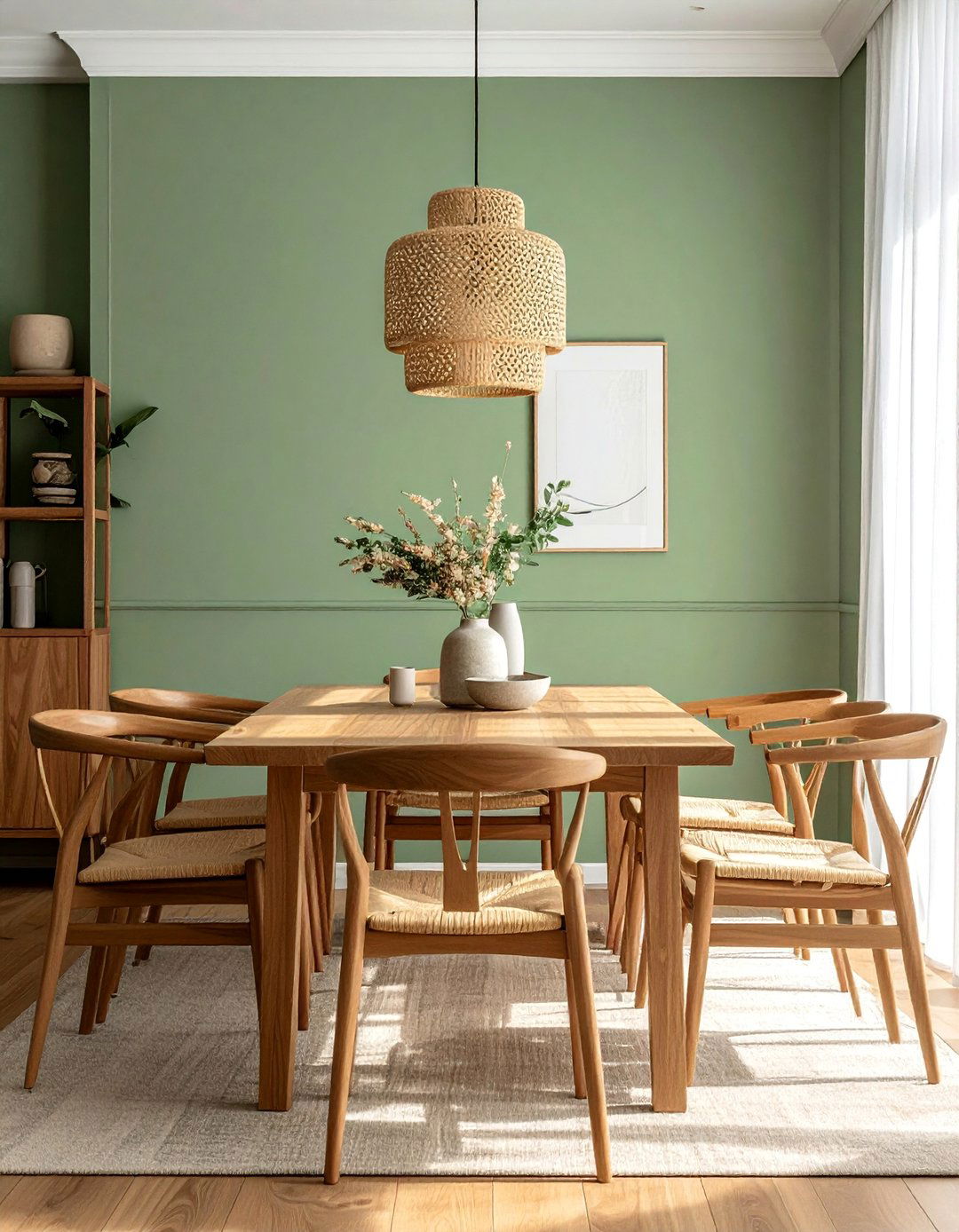
Combining sage green with natural wood tones results in a dining room that feels grounded, organic, and effortlessly warm. The earthy quality of sage green walls or cabinetry is beautifully complemented by the rich textures of a solid oak, walnut, or mango wood dining table. This pairing evokes a sense of bringing the outdoors in, perfect for creating a biophilic design. To enhance this connection to nature, consider adding wooden dining chairs, a sideboard with a natural wood finish, and decor elements like woven rattan pendant lights or wooden picture frames. The combination is timeless, balancing the coolness of green with the inherent warmth of wood.
4. Sage Green Lower Walls with Wainscoting
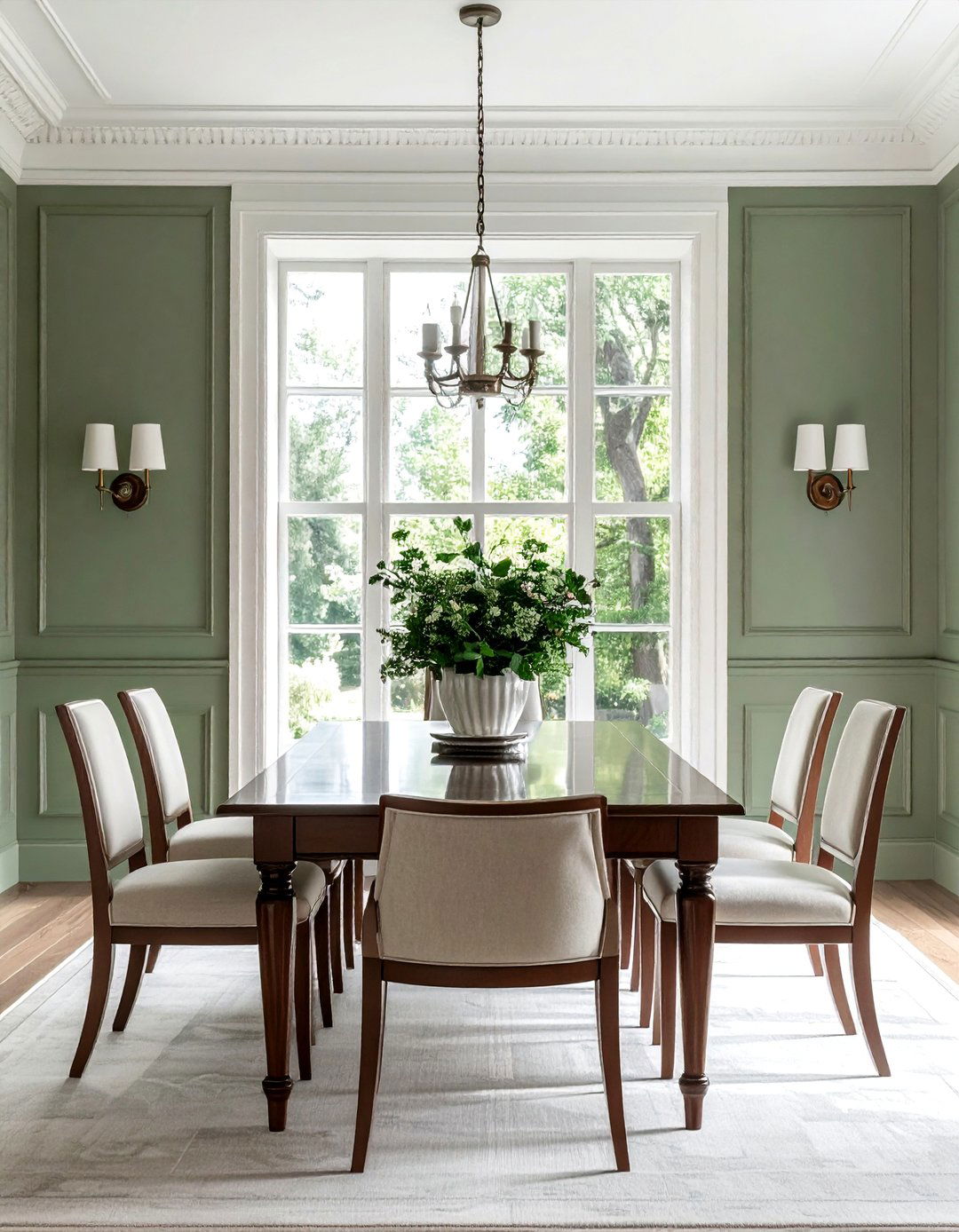
A classic and elegant approach involves using sage green on the lower portion of the walls with wainscoting. Painting the detailed woodwork in this soft green hue, while keeping the upper walls a contrasting bright white or creamy beige, adds traditional charm and visual structure. This technique makes the room feel taller and more refined. It works exceptionally well in formal or traditional dining spaces. Pair this look with a dark wood dining set to create a sophisticated contrast, or opt for a white-painted table for a lighter, more cottage-inspired feel. A polished brass chandelier and classic artwork complete this polished and timeless design.
5. Sage Green Dining Chairs
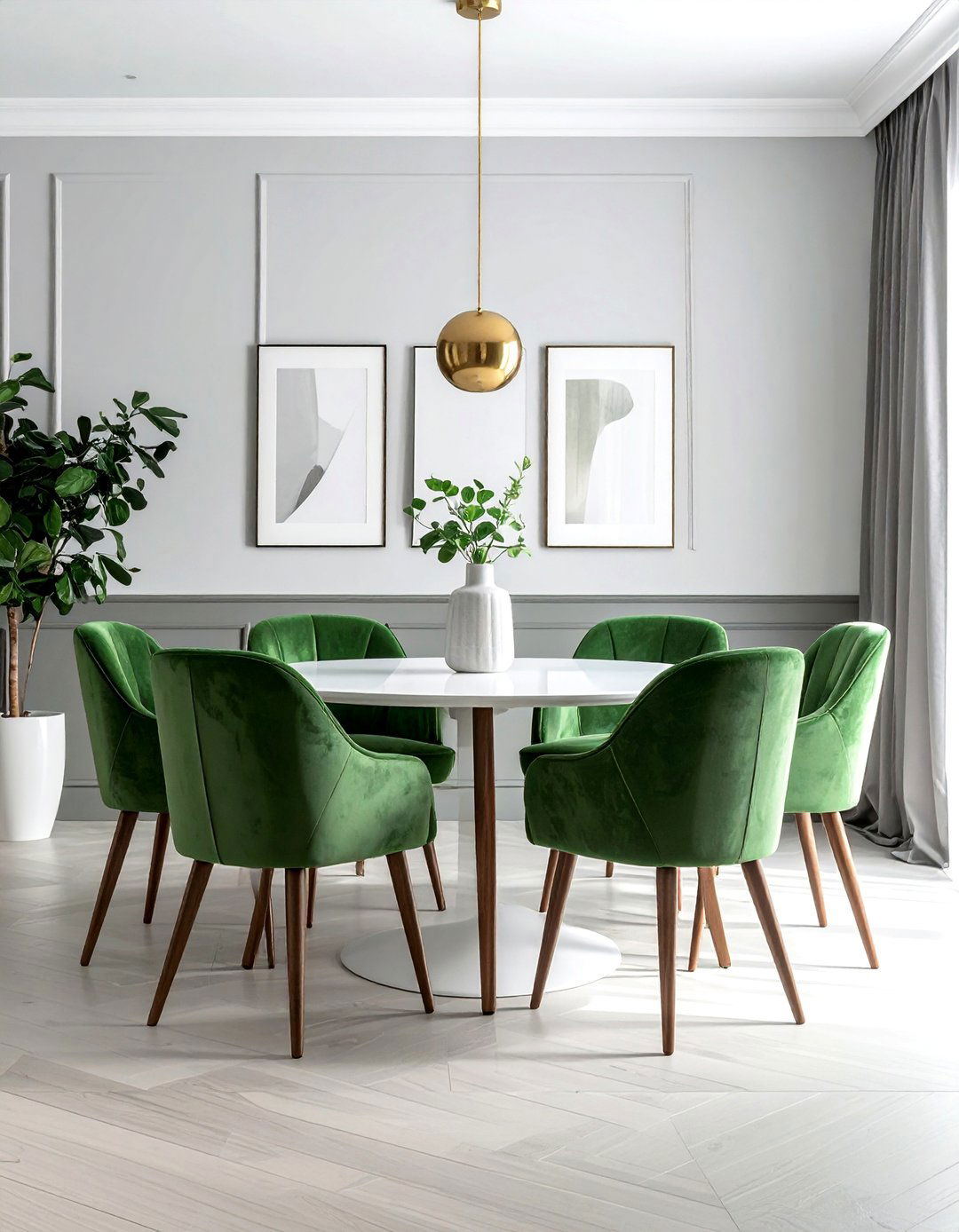
Incorporating sage green through dining chairs is a fantastic way to introduce color without committing to painting the walls. A set of sage green upholstered or painted wooden chairs can instantly refresh a neutral dining space. Placed around a simple wooden or white dining table, these chairs become the room's centerpiece, adding a subtle yet impactful pop of color. This idea is particularly effective in minimalist or Scandinavian-inspired dining rooms where the focus is on clean lines and functional beauty. Consider velvet or linen upholstery for a touch of texture and comfort, enhancing the inviting atmosphere of the room.
6. Sage Green with Gold and Brass Accents
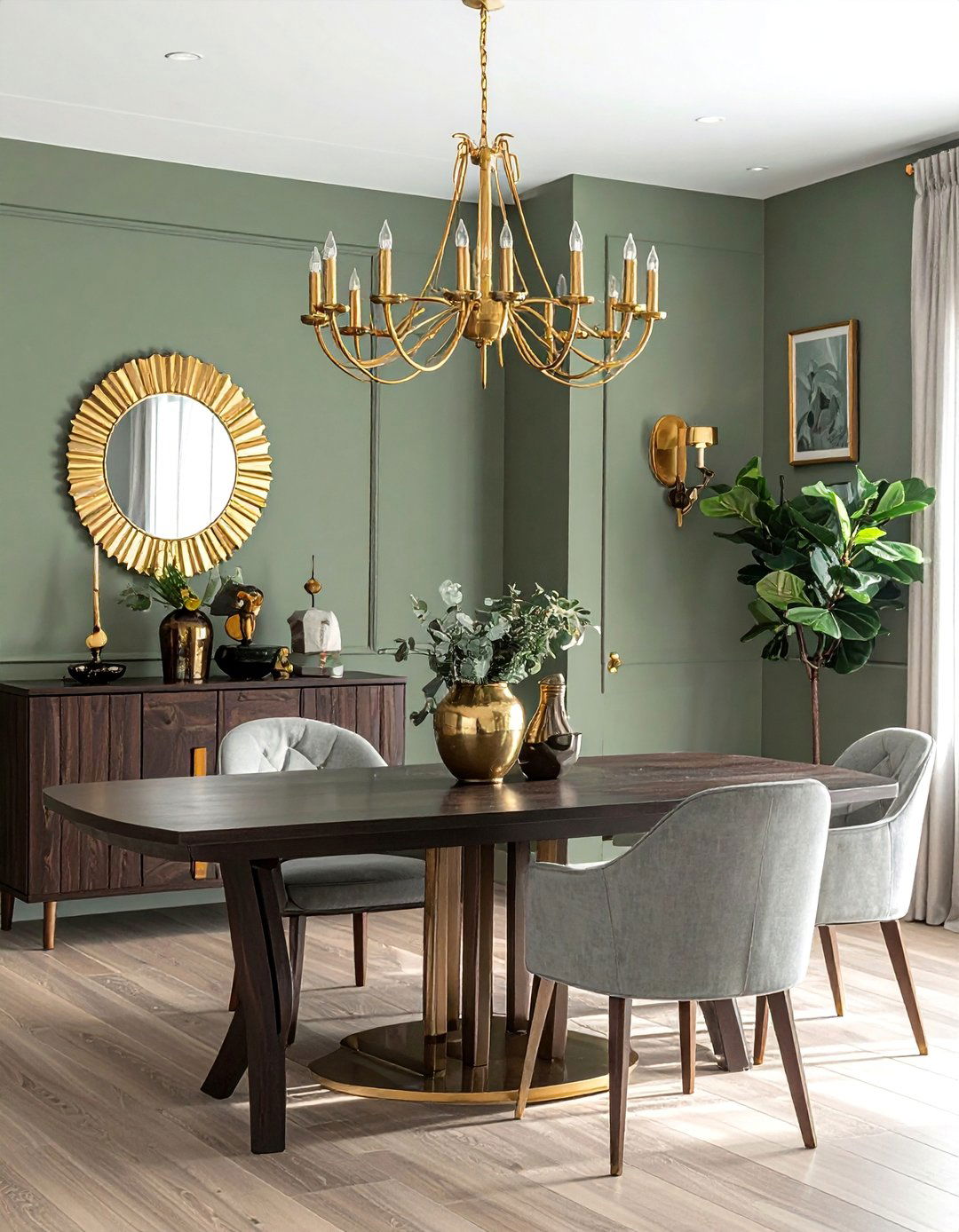
Pairing sage green with the warm, reflective qualities of gold or brass accents creates a look of understated luxury. The cool, earthy green provides a perfect backdrop for the metallic sheen, resulting in a dining room that feels both glamorous and inviting. Introduce these accents through a statement brass chandelier hanging over the dining table, gold-framed mirrors or artwork, and brass hardware on a sideboard or buffet. Even smaller details like brass candle holders or flatware can contribute to this sophisticated aesthetic. This combination works beautifully in modern, traditional, and Art Deco-inspired dining spaces, adding a layer of warmth and elegance.
7. Modern Farmhouse Sage Green Dining Room
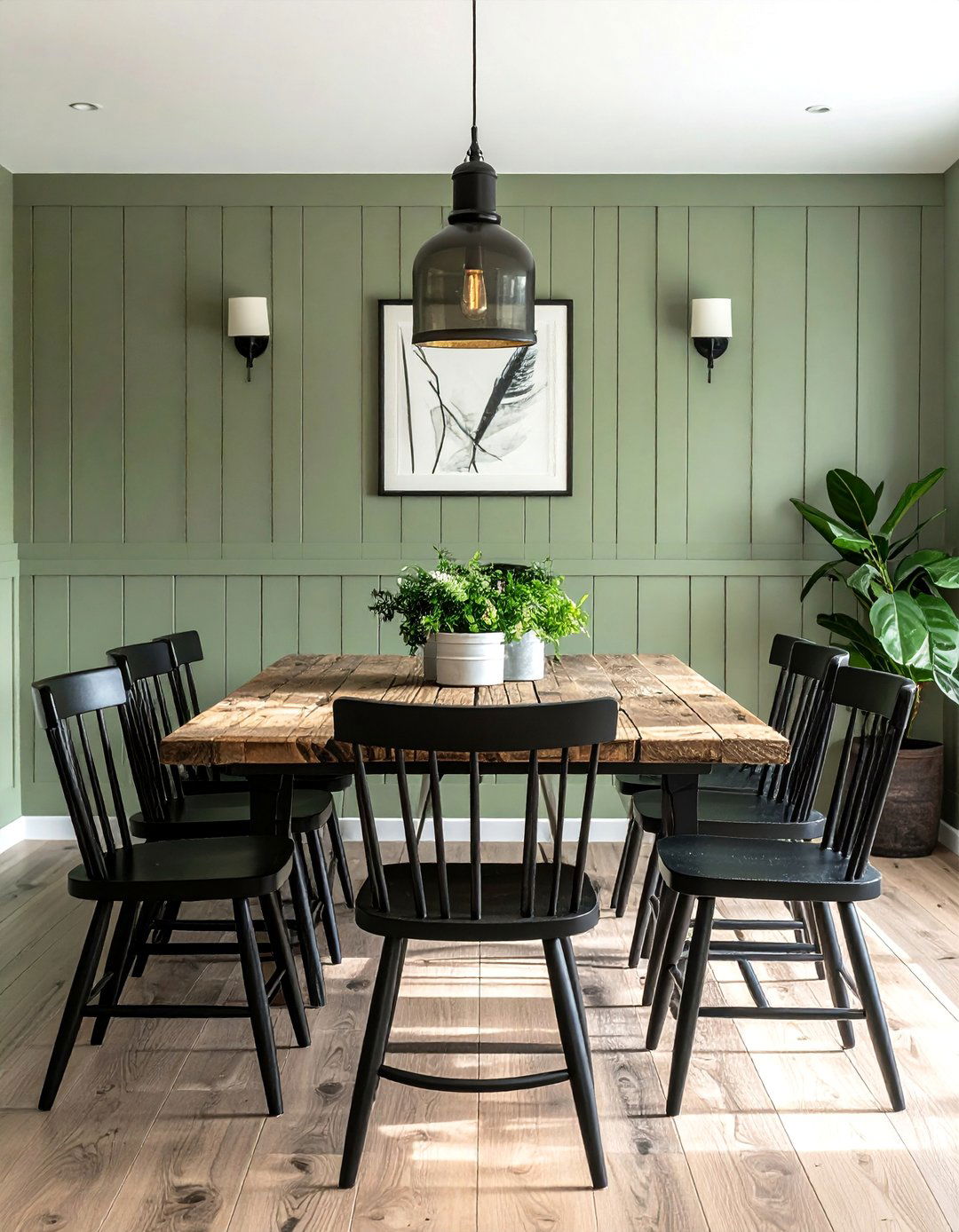
In a modern farmhouse dining room, sage green brings a soft, natural element that perfectly complements the style's core principles. Use sage green on a shiplap accent wall or on built-in cabinetry for a subtle touch of color. This pairs wonderfully with a large, rustic trestle dining table made of reclaimed wood and surrounded by black Windsor-style chairs. A galvanized metal light fixture or a simple beaded chandelier overhead reinforces the farmhouse aesthetic. Keep the remaining decor simple with linen textiles, ceramic vases filled with fresh greenery, and a neutral-toned area rug to complete this cozy and welcoming dining space.
8. Sage Green and Crisp White Contrast
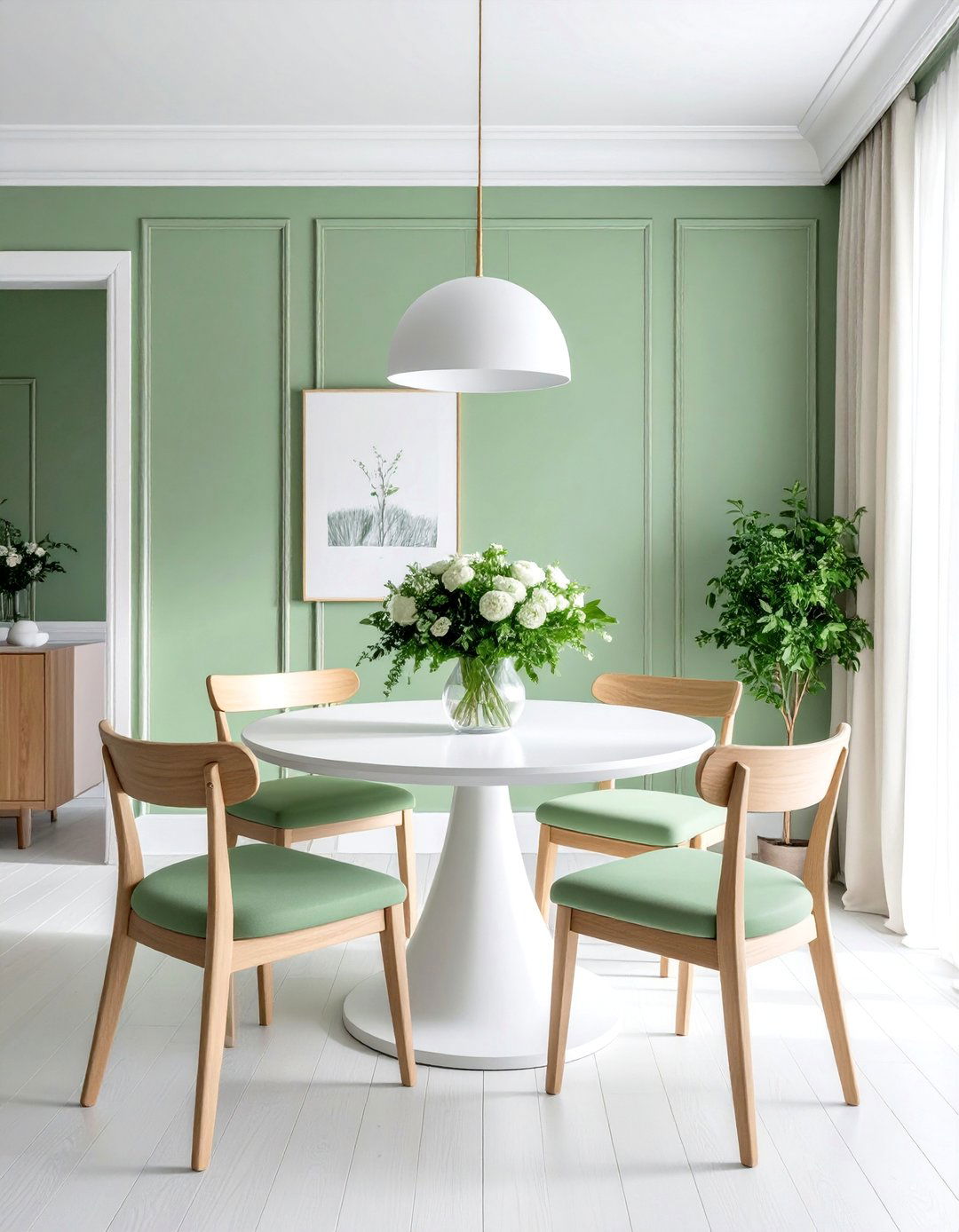
The combination of sage green and crisp white creates a dining room that feels fresh, airy, and exceptionally clean. This high-contrast pairing is versatile and can be adapted to suit various design styles, from coastal to contemporary. Consider painting the walls sage green and using crisp white for the trim, ceiling, and even the dining furniture for a bold yet balanced look. Alternatively, white walls with a sage green accent, such as a painted sideboard or curated decor, can be just as effective. This palette maximizes natural light, making the dining room feel larger and more open, while the green adds a gentle touch of nature-inspired color.
9. Bohemian Sage Green Dining Space
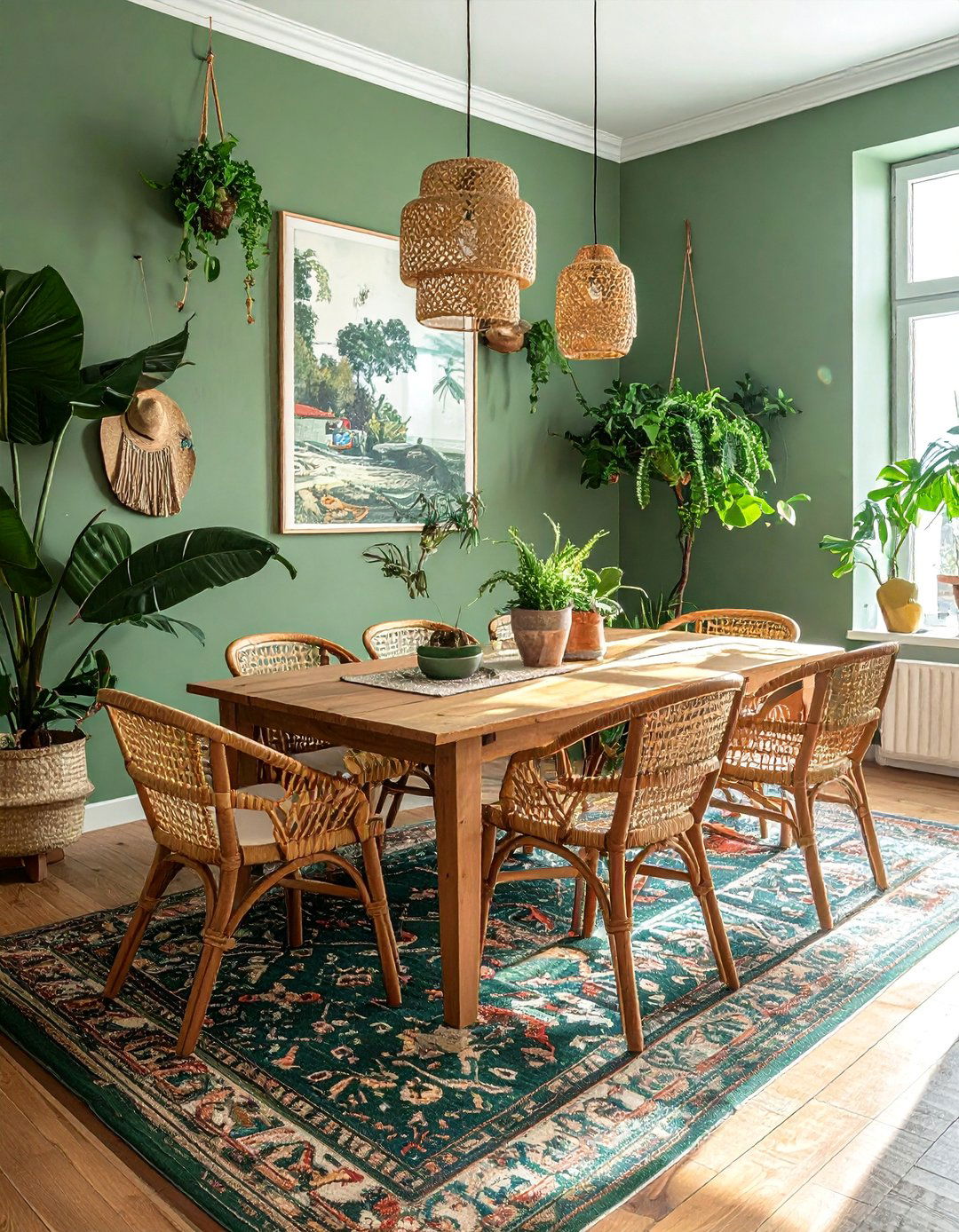
A bohemian dining room thrives on an eclectic mix of textures, patterns, and natural elements, and sage green serves as the perfect grounding color. Use it on the walls to create a calming canvas for more vibrant and varied decor. Layer the space with a vintage Persian rug, mismatched wooden and rattan chairs, and macrame wall hangings. A large, low-hanging rattan pendant light above the dining table enhances the boho vibe. Abundant houseplants, such as trailing pothos and fiddle leaf figs, are essential to this style and will beautifully complement the sage green walls, creating a lush, relaxed, and free-spirited dining atmosphere.
10. Sage Green and Black Metal Fixtures
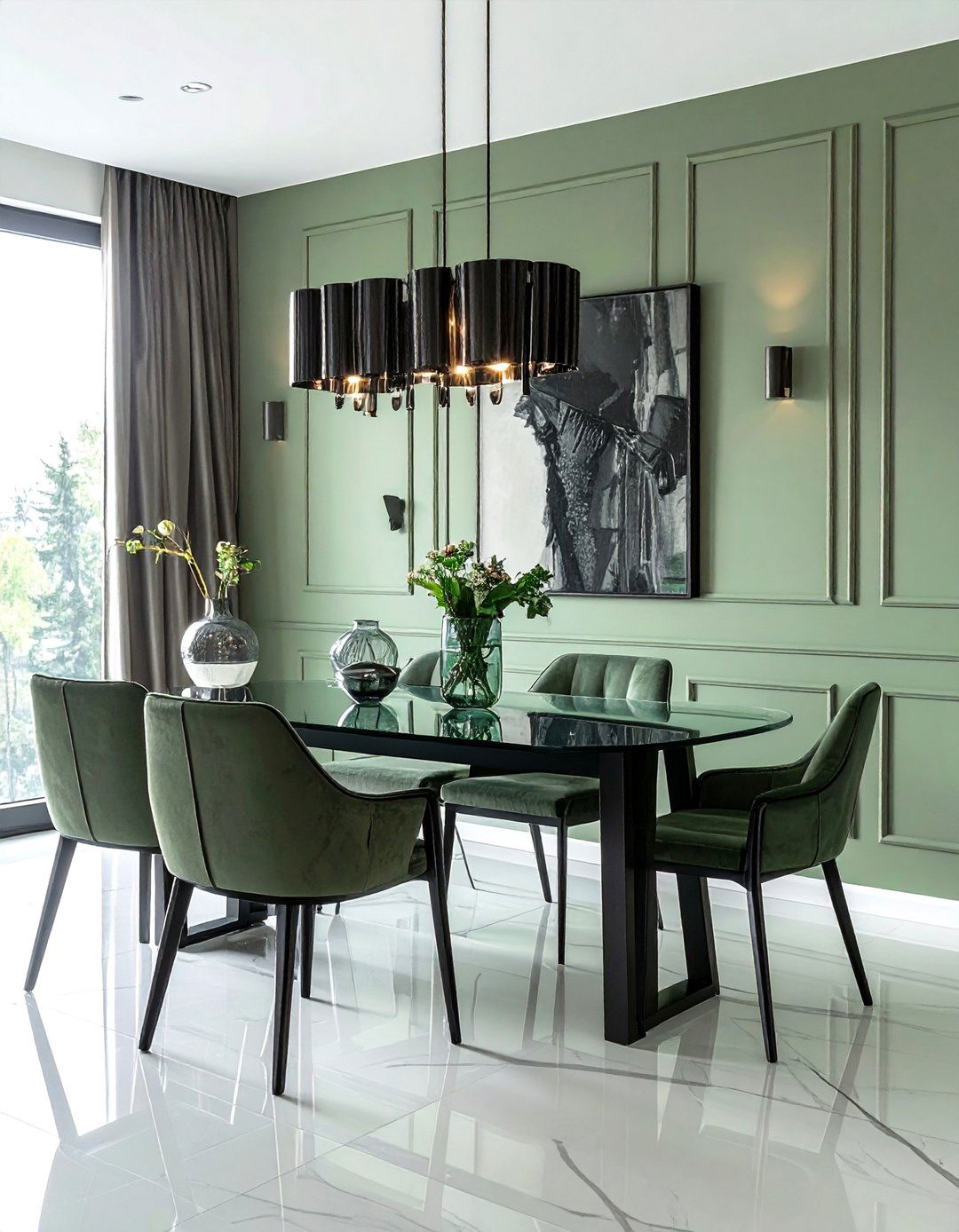
For a more contemporary or industrial edge, combine sage green with bold black metal fixtures. The softness of sage green provides a beautiful contrast to the strong, clean lines of black metal. This combination works well for light fixtures, such as a modern black chandelier or track lighting, as well as for the frames of dining chairs or the legs of a dining table. The black elements add a graphic, modern touch that prevents the sage green from feeling too traditional or muted. This pairing is ideal for creating a sophisticated dining space that feels both current and timelessly stylish.
11. Sage Green Curtains or Drapery
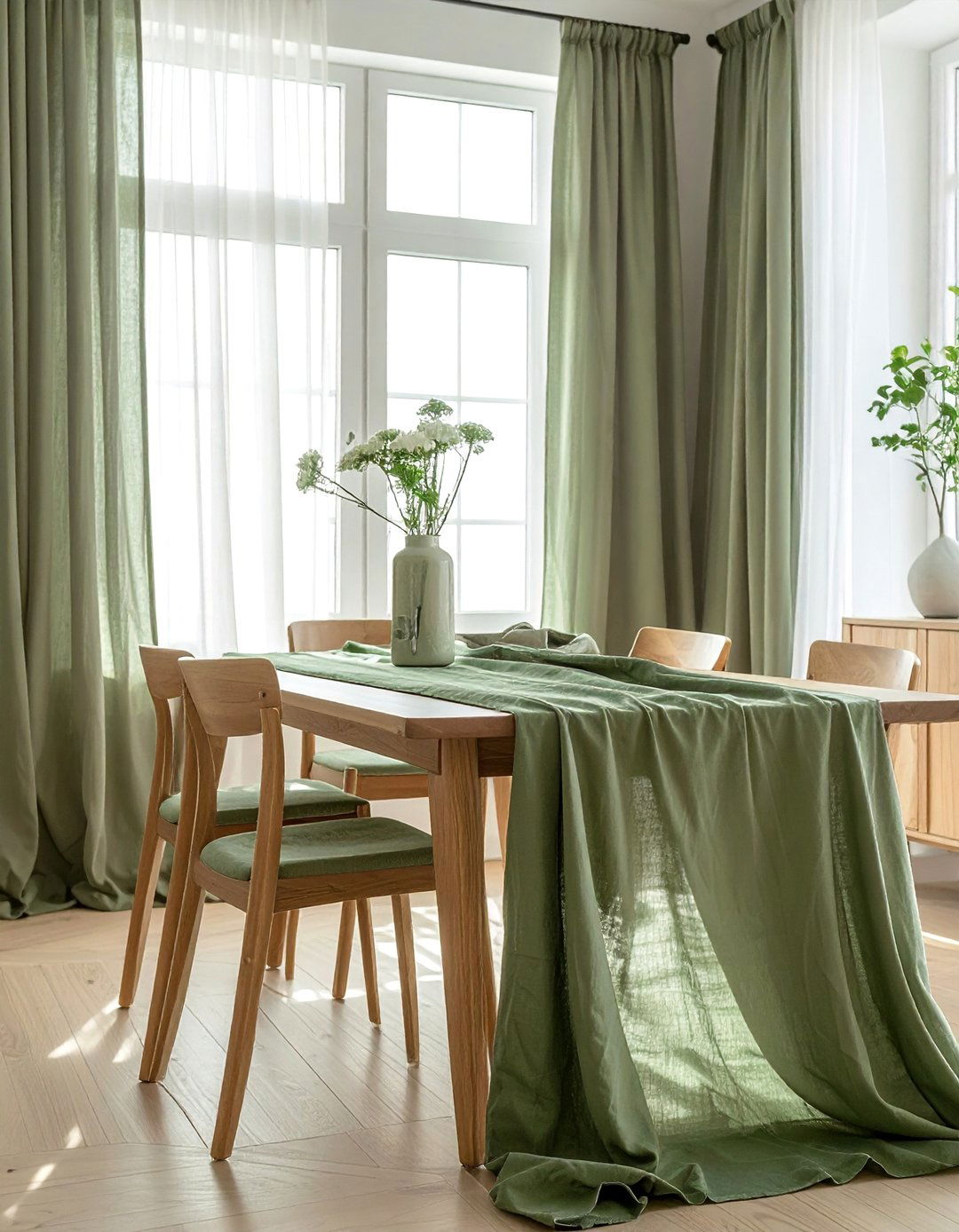
If you prefer neutral walls, introducing sage green through curtains or drapery is an excellent way to add color and softness to the dining room. Floor-to-ceiling sage green curtains in a luxurious fabric like velvet or a more casual linen can frame the windows beautifully, creating a soft focal point. This approach allows you to easily update the room's color scheme in the future. The drapery adds a layer of texture and can help absorb sound, making the dining space feel more intimate and comfortable. Pair the curtains with other subtle sage accents, like placemats or a centerpiece, to tie the look together.
12. Minimalist Sage Green Dining Room
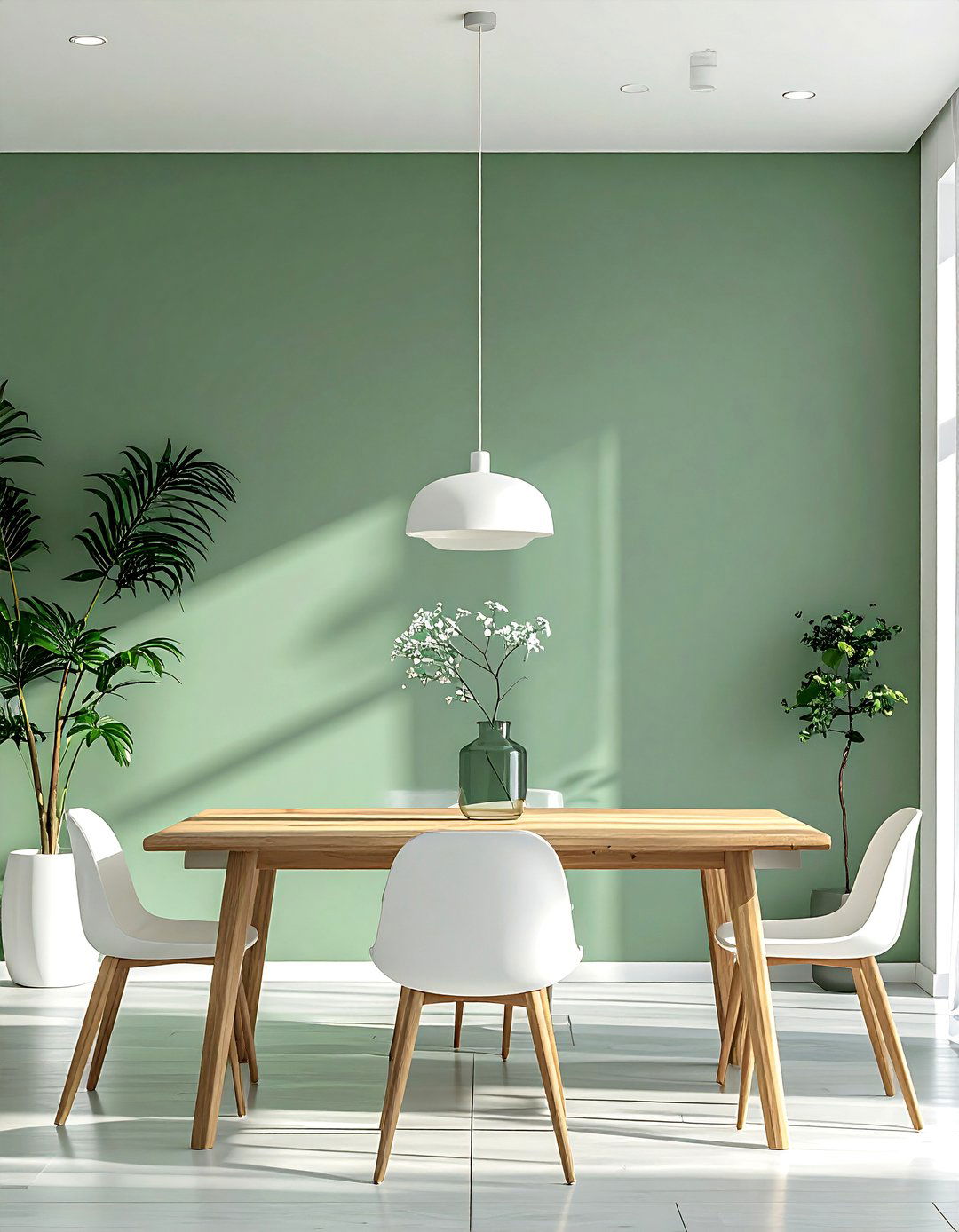
In a minimalist dining room, sage green can be used to add warmth and personality without creating visual clutter. A single sage green accent wall or a large piece of abstract art with sage tones can provide just enough color to soften the starkness of a minimalist aesthetic. Pair it with a simple, clean-lined dining table in a light wood or white finish and sleek, unadorned chairs. Keep decor to a minimum, focusing on a few high-quality pieces, such as a single ceramic vase or a modern pendant light. The result is a serene and sophisticated space that feels intentional and calming.
13. Sage Green and Cream Color Palette
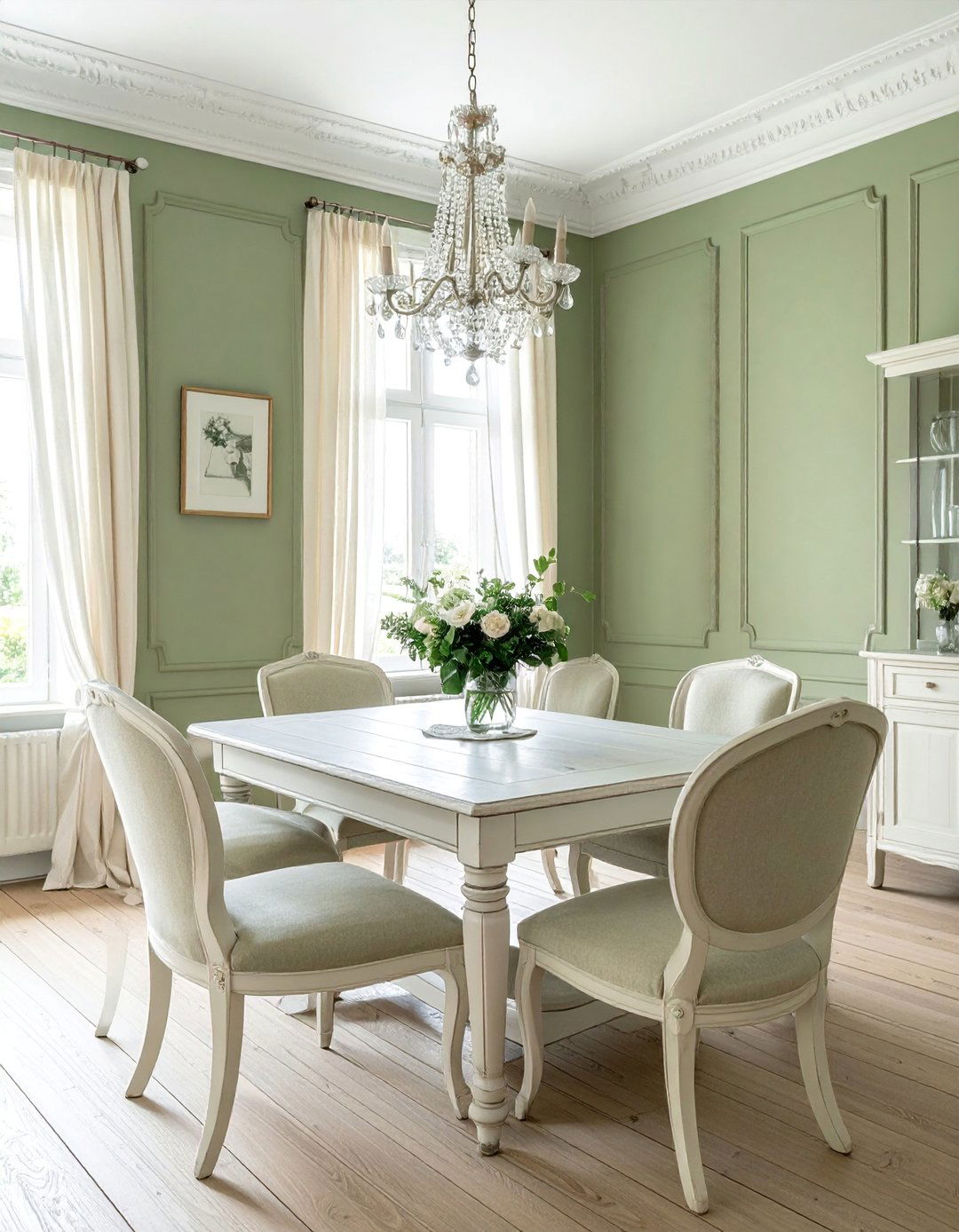
A dining room decorated in a palette of sage green and cream exudes a soft, gentle elegance that is both classic and comforting. This low-contrast combination creates a harmonious and restful atmosphere perfect for leisurely meals. Use sage green for the walls and cream for the trim, curtains, and upholstered dining chairs. A dining table in a light, whitewashed wood would complement this palette perfectly. This color scheme is particularly well-suited for traditional, French country, or shabby chic styles, creating a space that feels bright, inviting, and effortlessly chic. Add warmth with subtle gold or aged brass accents for a polished finish.
14. Sage Green Painted Built-in Cabinetry
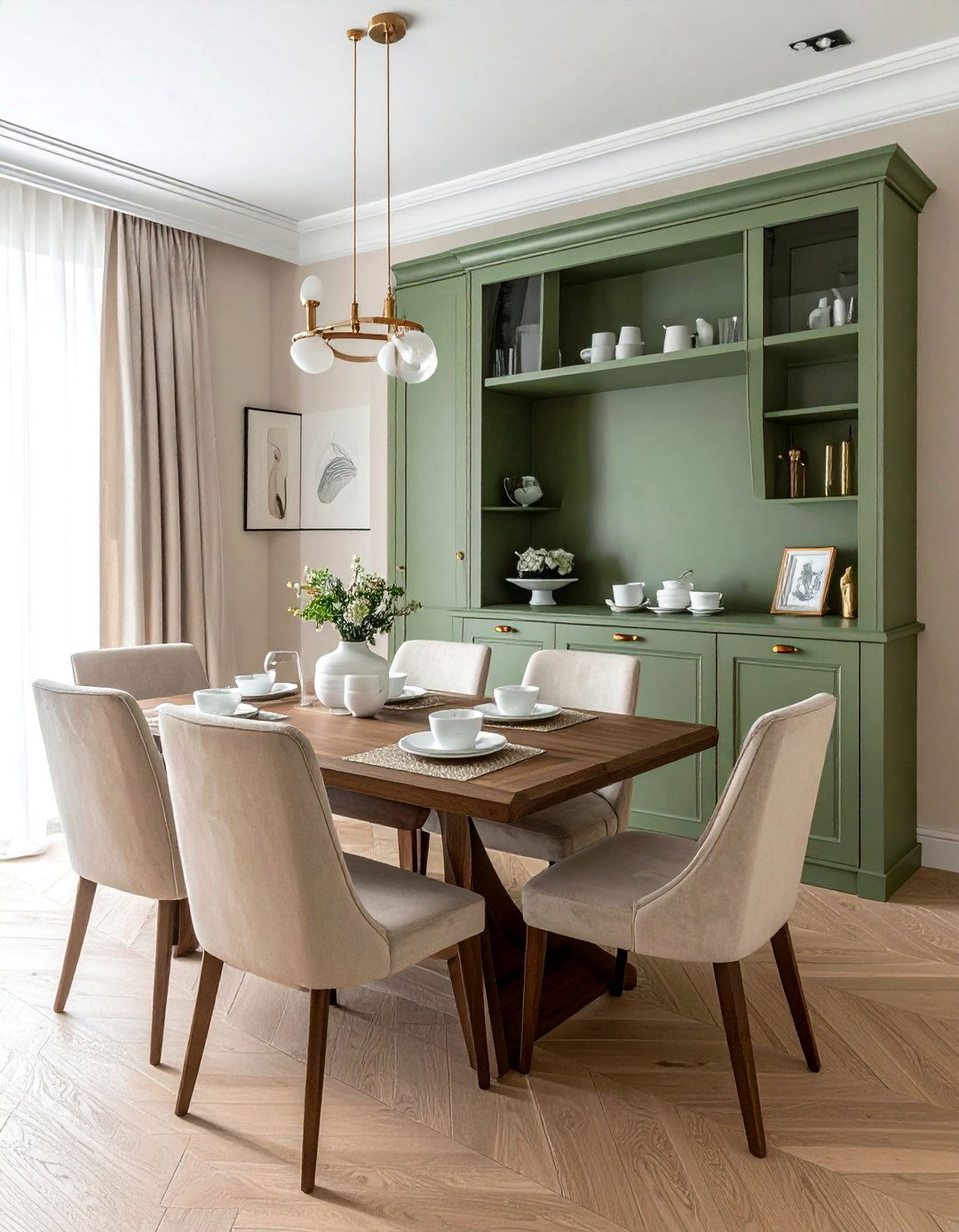
For dining rooms that feature built-in cabinetry, a buffet, or a hutch, painting these pieces sage green is a brilliant way to create a custom, high-end look. This turns a functional storage element into a stunning design feature. The sage green cabinetry provides a beautiful backdrop for displaying white ceramic dinnerware, glassware, or decorative objects. To complete the design, use hardware in a contrasting finish like matte black, polished nickel, or champagne bronze. This approach adds a significant dose of character and color while maintaining a sophisticated and cohesive feel throughout the dining space, especially when paired with neutral walls.
15. Coastal Inspired Sage Green Decor
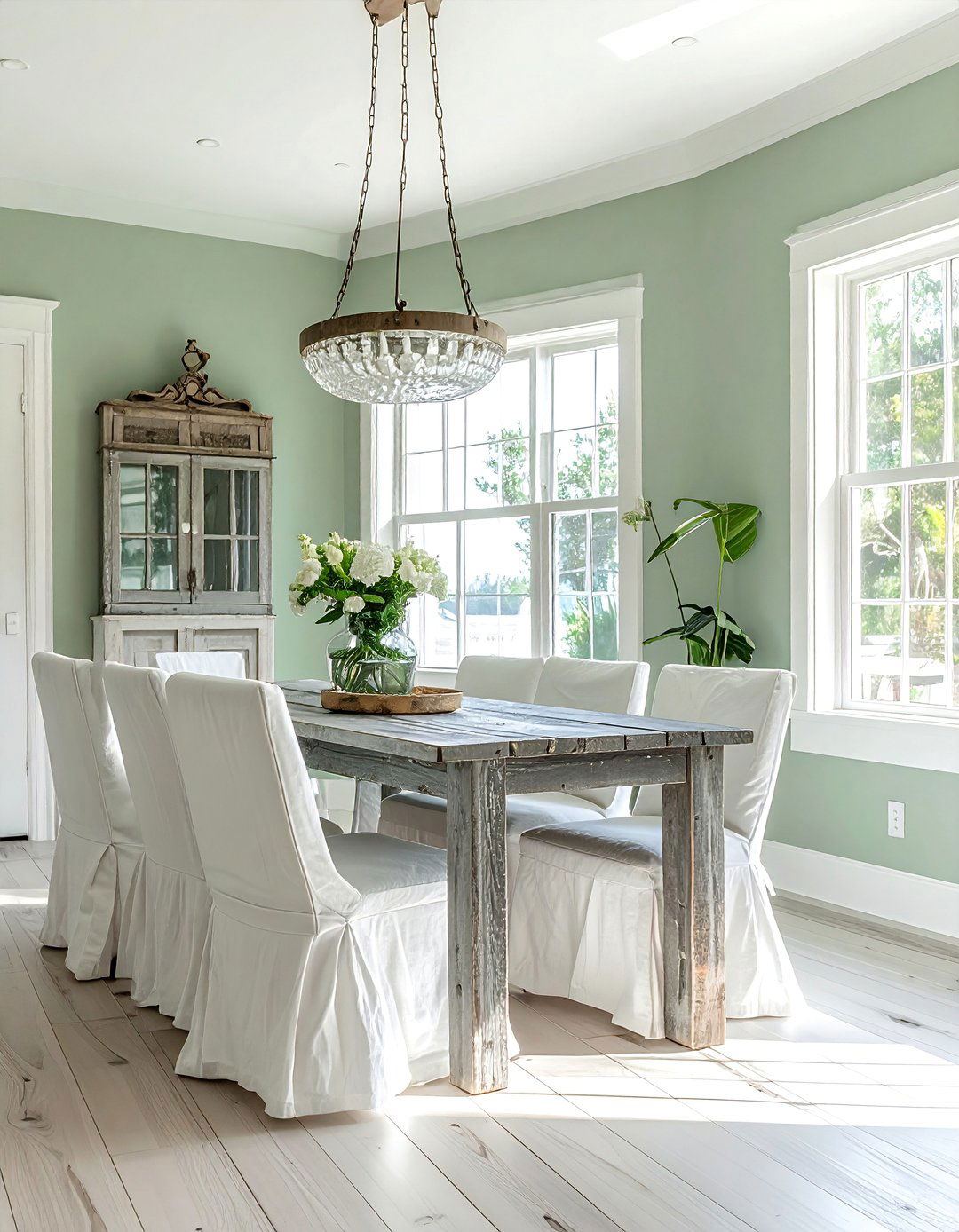
Sage green is a natural fit for a coastal-inspired dining room, evoking the soft, misty colors of the shoreline. Pair light sage green walls with weathered wood furniture, a jute or sisal rug, and light, airy linen curtains. The key is to create a relaxed and breezy atmosphere. Decorate with coastal-themed elements such as driftwood, seashells in glass jars, and artwork depicting seascapes. Upholstered dining chairs in a light neutral stripe or a simple white slipcover will enhance the beachy vibe. This design creates a serene retreat where every meal feels like a peaceful seaside getaway.
16. Sage Green and Pink Tones
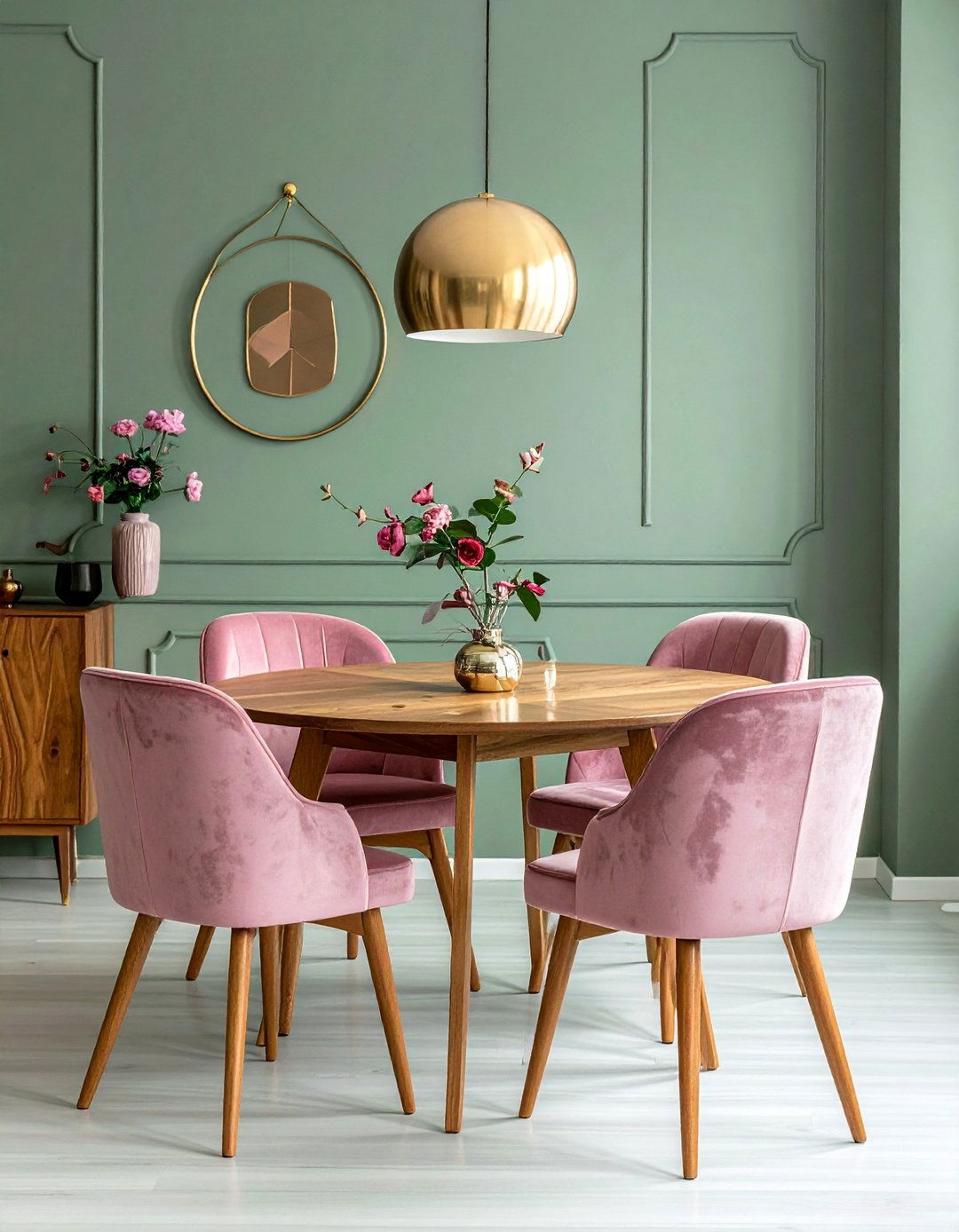
Combining sage green with soft pink or dusty rose tones creates a dining room that is charming, modern, and slightly unexpected. The earthy green and the warm pink balance each other beautifully, resulting in a sophisticated and playful palette. This can be achieved with sage green walls and dusty pink upholstered chairs, or a neutral dining room with accents of both colors in the rug, artwork, and table decor. This color combination feels fresh and contemporary, perfect for someone looking to create a unique and stylish dining space. Add touches of brass or gold to elevate the look and add a touch of glamour.
17. Sage Green and Dark Wood Floors
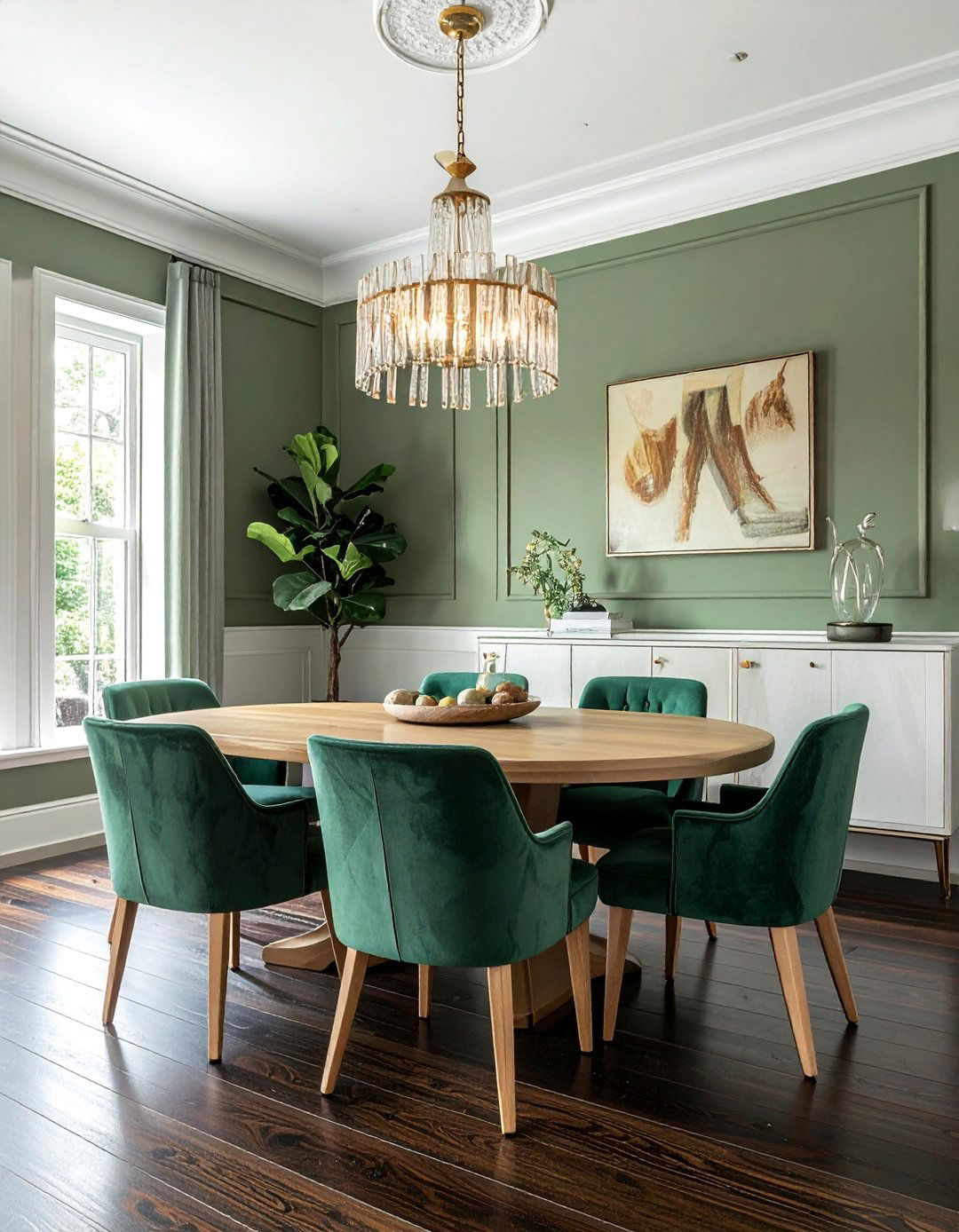
Sage green walls look particularly stunning when contrasted with the richness of dark wood floors. The deep, warm tones of walnut, cherry, or espresso-stained flooring provide a grounding element that makes the soft green on the walls pop. This classic combination creates a sense of depth and sophistication in the dining room. To balance the dark floors, opt for lighter furniture, such as a dining table in a medium or light wood tone, or chairs upholstered in a cream or beige fabric. A light-colored rug under the dining table can also help to define the space and brighten the room.
18. Sage Green Patterned Wallpaper
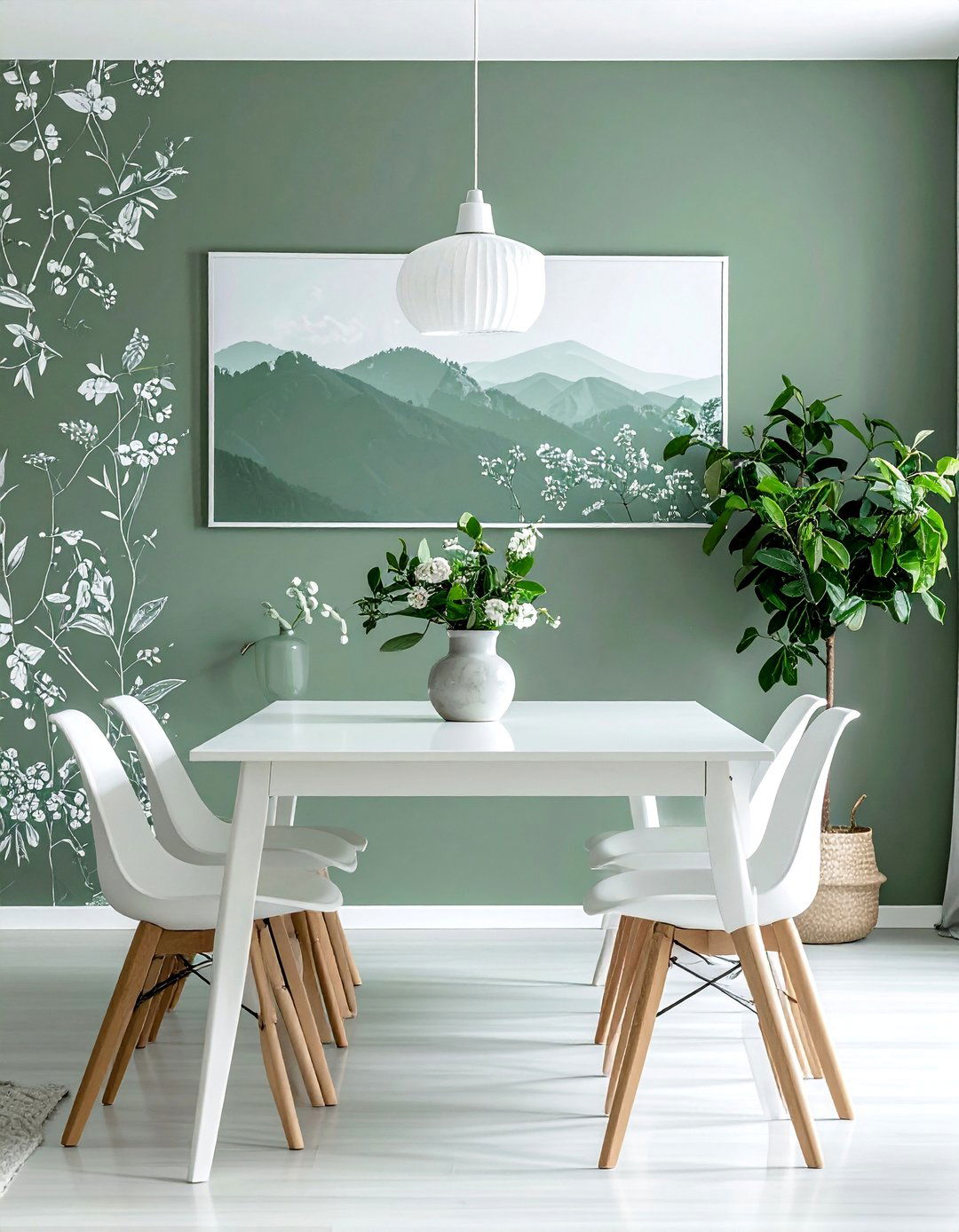
For a more dramatic and visually interesting effect, consider using a sage green patterned wallpaper on an accent wall or throughout the entire dining room. Choose a pattern that suits your style, whether it's a delicate floral or botanical print for a traditional or romantic look, or a bold geometric design for a more modern feel. The wallpaper instantly adds personality, texture, and depth to the space. When using a busy pattern, keep the furniture and other decor relatively simple and streamlined to let the wallpaper be the star of the show. This is a powerful way to make a memorable design statement.
19. Scandinavian Sage Green Dining Area
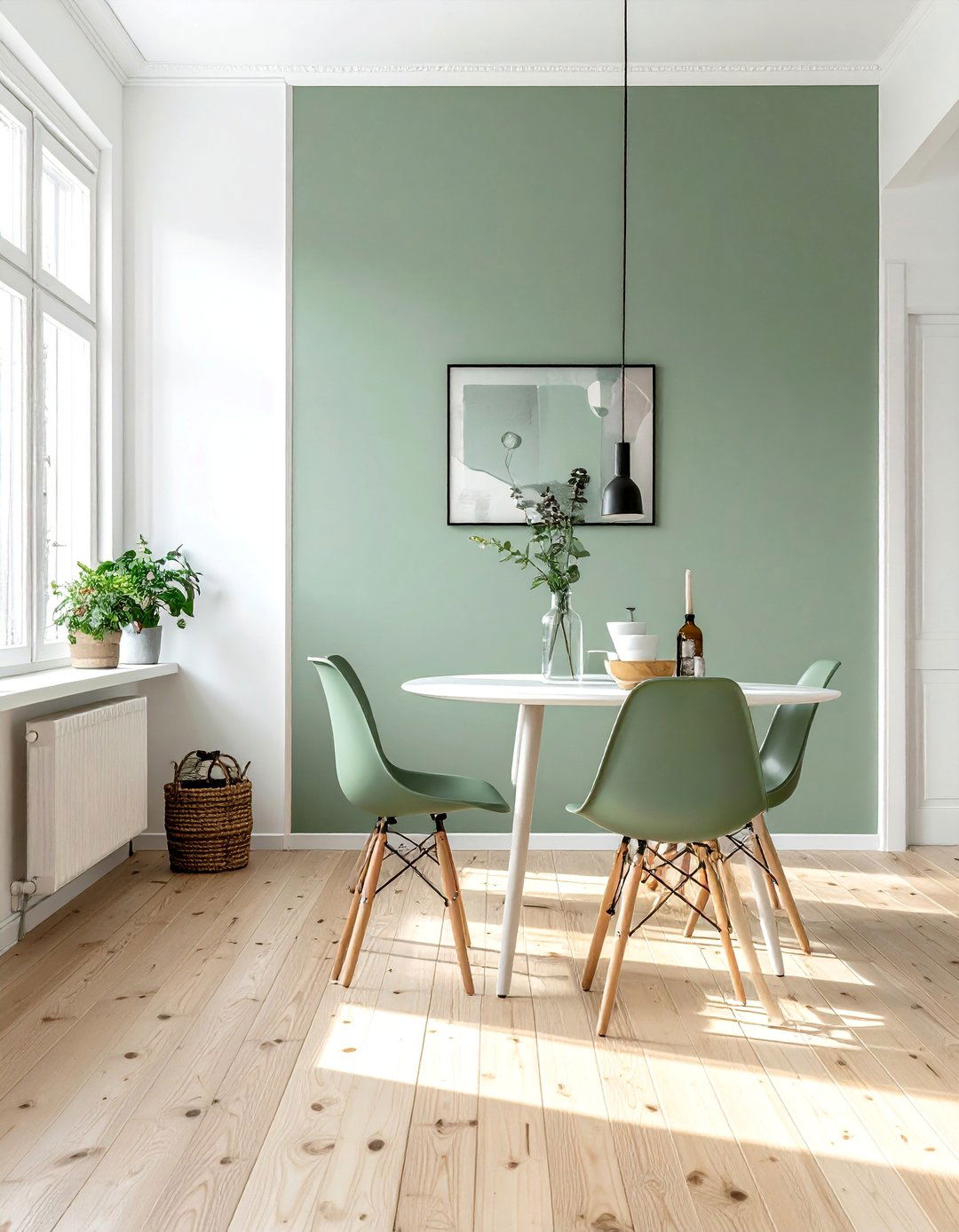
In a Scandinavian-inspired dining area, sage green adds a touch of organic color to the typically neutral and light-filled palette. Use it sparingly, perhaps on a single wall or through textile accents like a tablecloth or seat cushions. The focus of Scandinavian design is on simplicity, functionality, and natural materials. Pair the sage green element with a light wood dining table (like birch or ash), iconic wishbone-style chairs, and simple white ceramic tableware. Maximize natural light with sheer curtains and keep the space uncluttered to achieve that signature hygge feeling of coziness and contentment.
20. Sage Green and Terracotta Hues
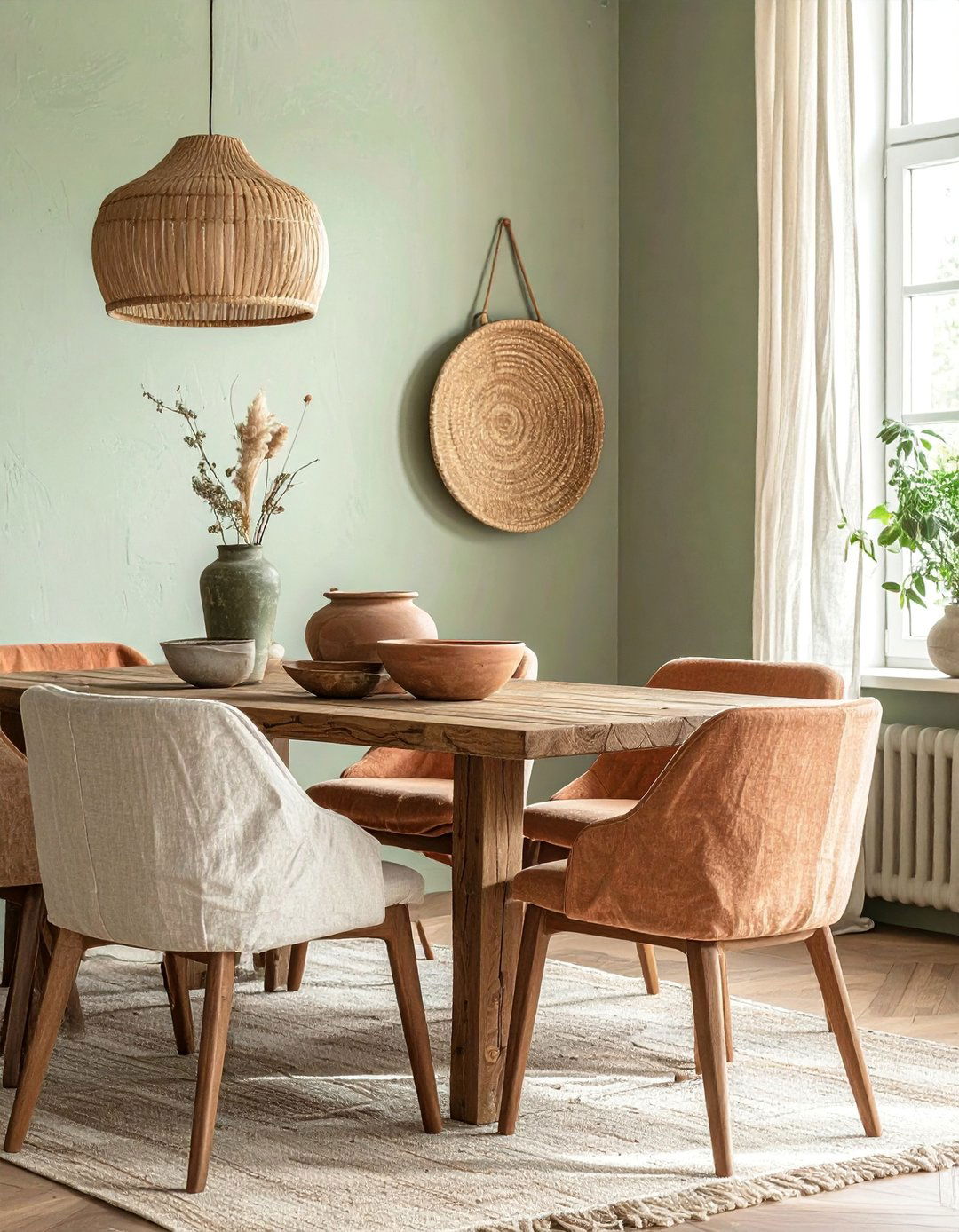
Pairing sage green with warm, earthy terracotta hues creates a dining room that feels rich, organic, and deeply connected to nature. This color combination is reminiscent of a sun-drenched Mediterranean landscape. Use sage green on the walls and introduce terracotta through decorative pots, upholstered chairs, or a patterned area rug. These two colors have a natural harmony that is both calming and invigorating. The warmth of terracotta balances the coolness of the sage green, resulting in a welcoming and stylish space. This palette works particularly well with rustic or bohemian design aesthetics, enhanced by natural textures like wood and linen.
21. Sage Green with a Statement Area Rug
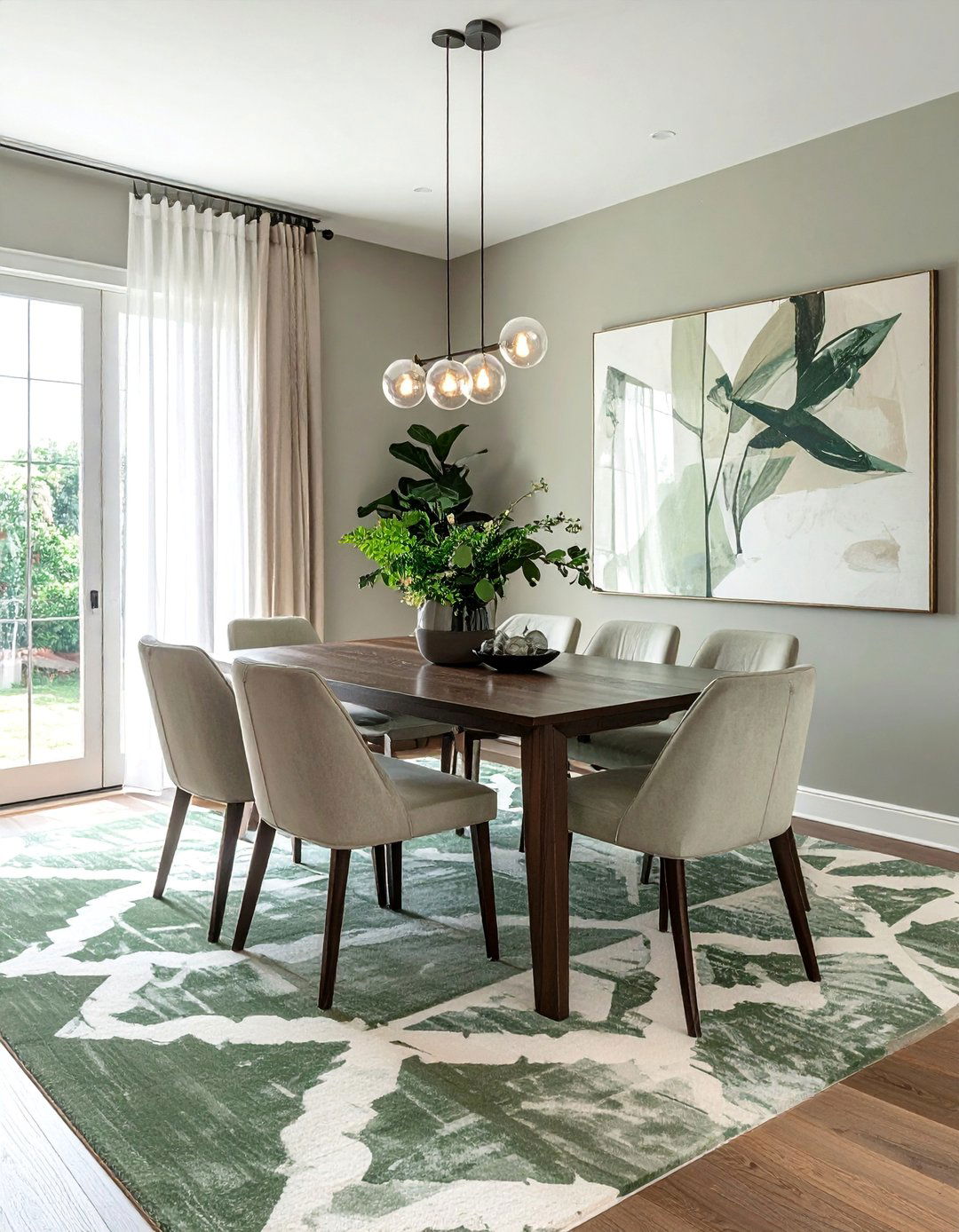
A statement area rug featuring sage green can serve as the foundation for the entire dining room's color scheme. Choose a rug with a bold pattern or a beautiful texture that incorporates various shades of sage along with complementary colors like cream, charcoal, or blush. This allows you to pull the sage green color from the floor up into other elements of the room, such as wall art, a table runner, or decorative vases. A rug not only adds color and pattern but also defines the dining area, adds warmth underfoot, and helps to absorb sound, making the space feel more comfortable and cohesive.
22. Sage Green Ceiling
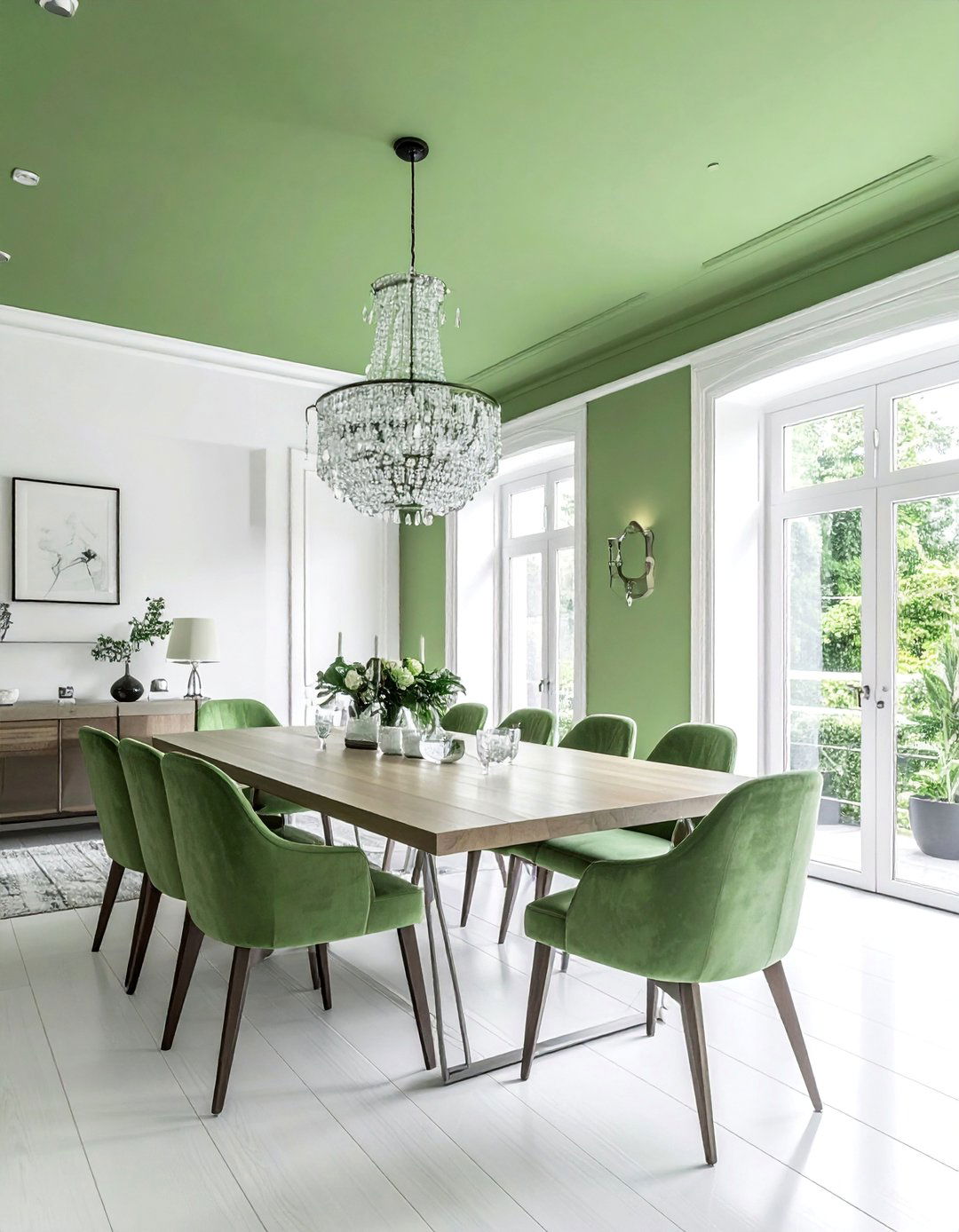
Painting the ceiling sage green is a bold and unexpected design choice that can make a dining room feel incredibly cozy and unique. This technique, often referred to as a "fifth wall," draws the eye upward and can create a sense of intimacy in a room with high ceilings. It works best when the walls are painted a contrasting neutral, such as a crisp white or a soft cream, which allows the ceiling to become a true feature. Pair this look with a stunning chandelier that hangs down from the center, further highlighting this creative application of color. It's a sophisticated touch for a truly memorable dining space.
23. Sage Green with a Marble Dining Table
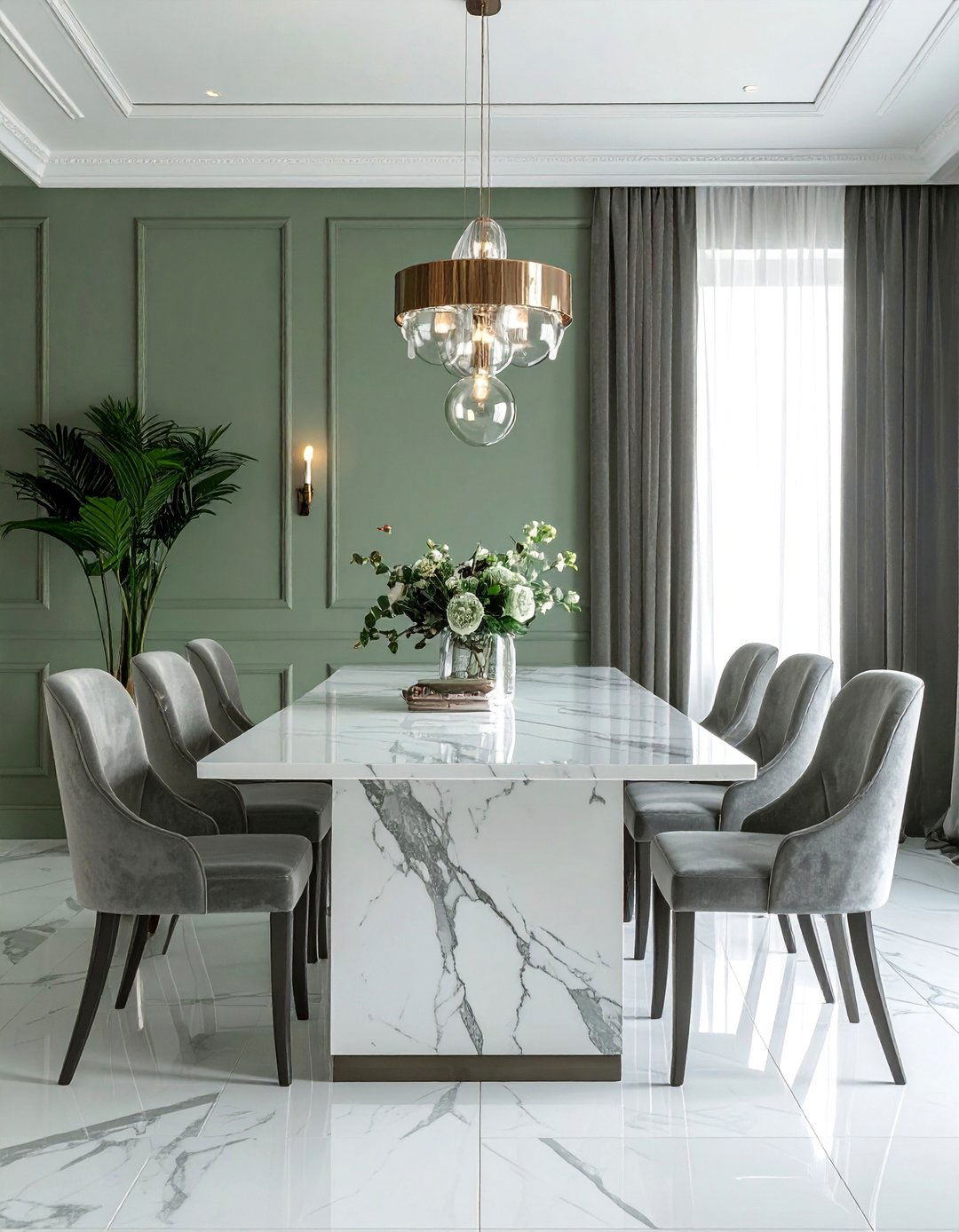
For a look of timeless elegance, pair sage green walls with a luxurious marble dining table. The cool, natural veining of a white or cream marble tabletop contrasts beautifully with the soft, earthy tones of sage green. This combination creates a sophisticated and high-end feel, perfect for a formal dining room. Complement the look with upholstered dining chairs in a neutral fabric like gray or beige to let the table and wall color shine. Metallic accents, such as a silver or brass light fixture and candle holders, will add the final touch of glamour to this refined and polished space.
24. Transitional Style Sage Green Dining Room
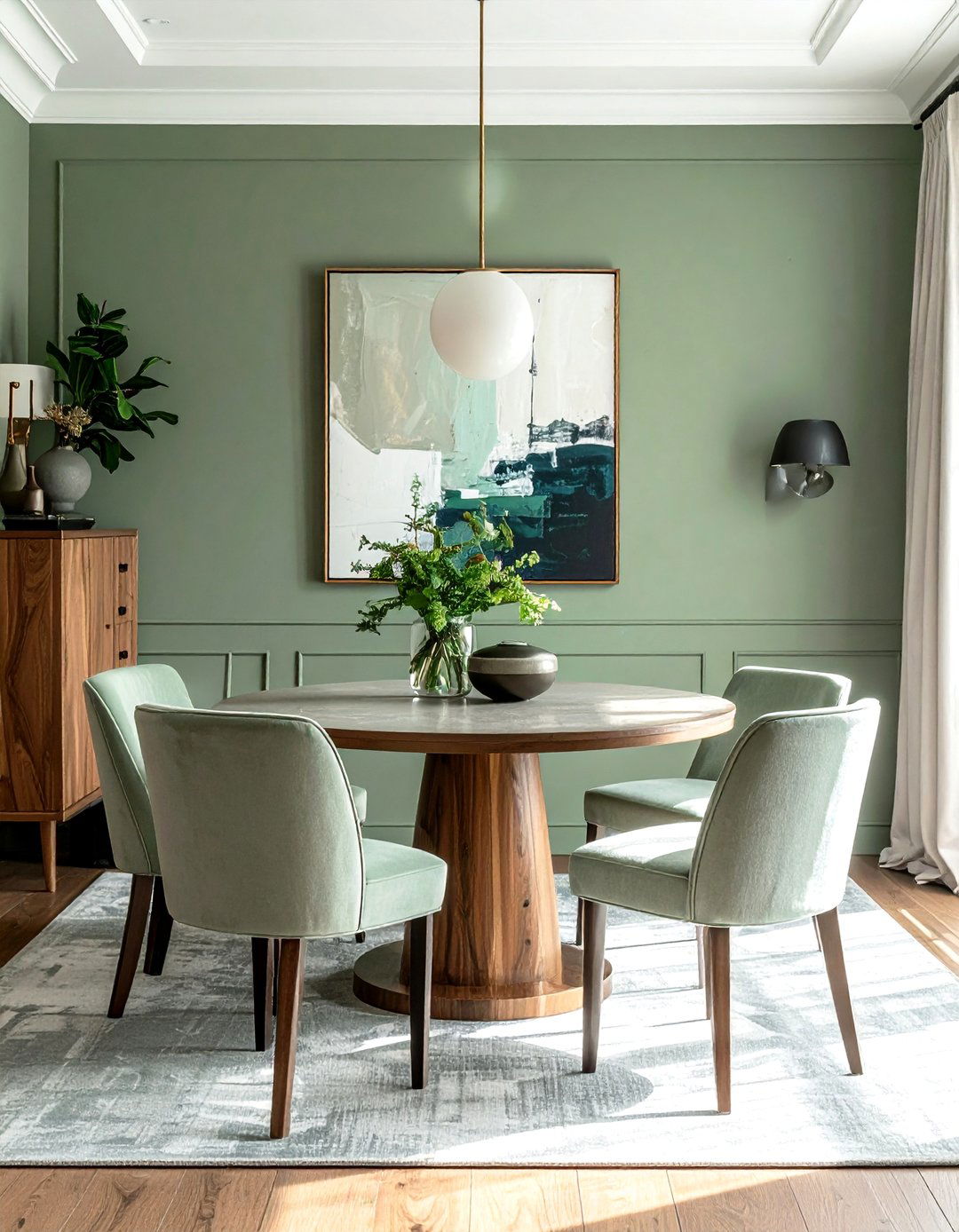
Sage green is an ideal color for a transitional style dining room, as it perfectly bridges the gap between traditional and contemporary design. Use a muted sage green on the walls to create a serene and sophisticated backdrop. Furnish the space with pieces that have classic lines but a modern, clean feel, such as a simple pedestal dining table and upholstered chairs with straight legs. A classic crystal chandelier can be paired with modern abstract art for a balanced look. The sage green acts as a versatile neutral, allowing the blend of old and new elements to feel harmonious and intentional.
25. Sage Green with Woven Rattan Details
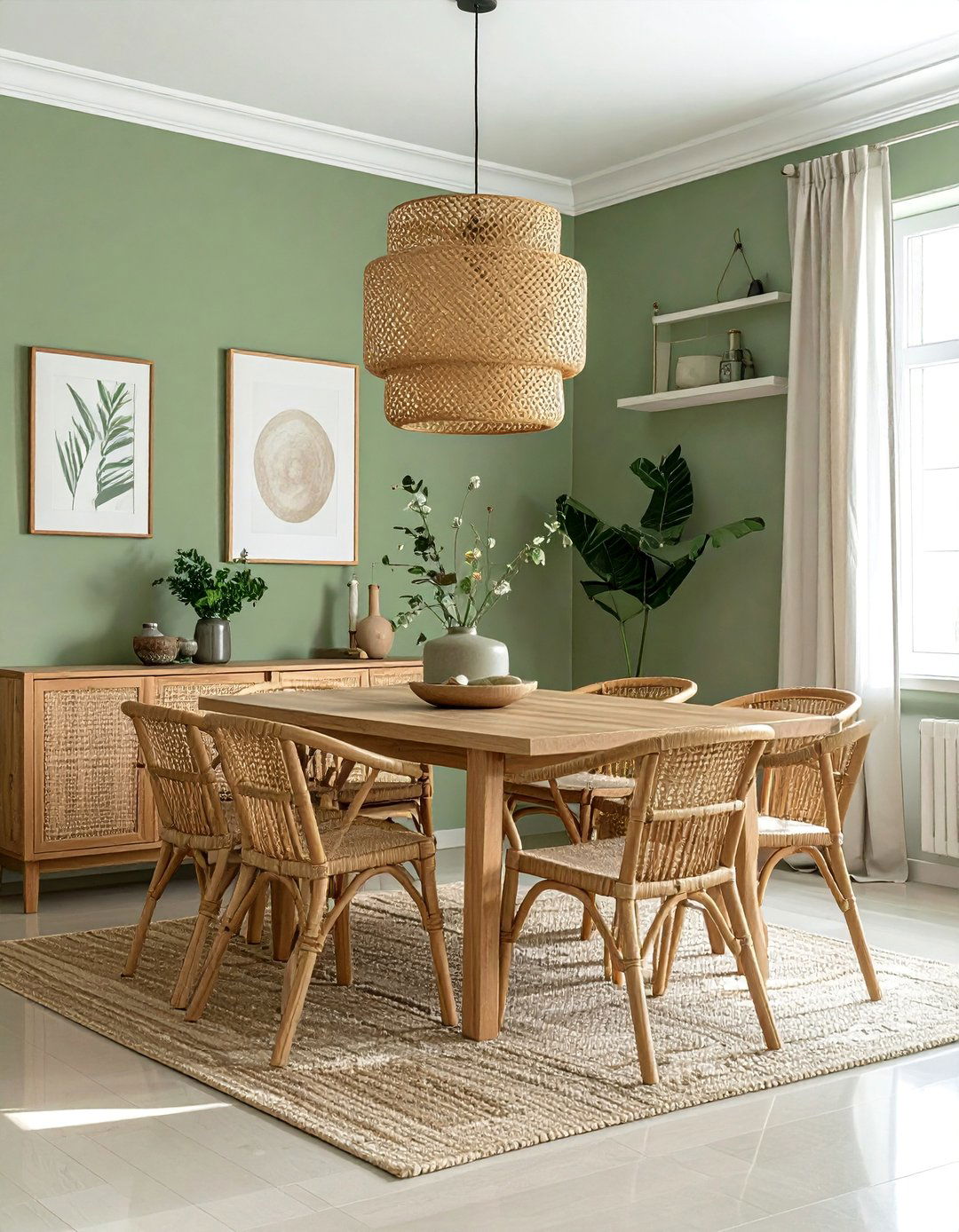
Introduce a natural, textural element to your sage green dining room with woven rattan details. This pairing is perfect for creating a relaxed, slightly bohemian, or coastal vibe. A large rattan pendant light hung over the dining table can serve as a stunning focal point. You can also incorporate rattan through the dining chairs, a bar cart, or decorative placemats. The light, natural color and organic texture of rattan complement the earthy sage green beautifully, enhancing the room's connection to nature. This combination creates a dining space that feels light, airy, and effortlessly stylish.
Conclusion:
Sage green is a remarkably versatile and calming color that can transform a dining room into a serene and stylish sanctuary. From creating an immersive, all-over green space to using it as a subtle accent on chairs, cabinetry, or decor, its adaptability suits countless styles. By pairing it with natural wood, crisp white, or warm metallics, you can craft a space that is uniquely yours. Whether your taste is modern farmhouse, minimalist, or bohemian, sage green provides a timeless and sophisticated foundation for a dining room that is both beautiful and welcoming.

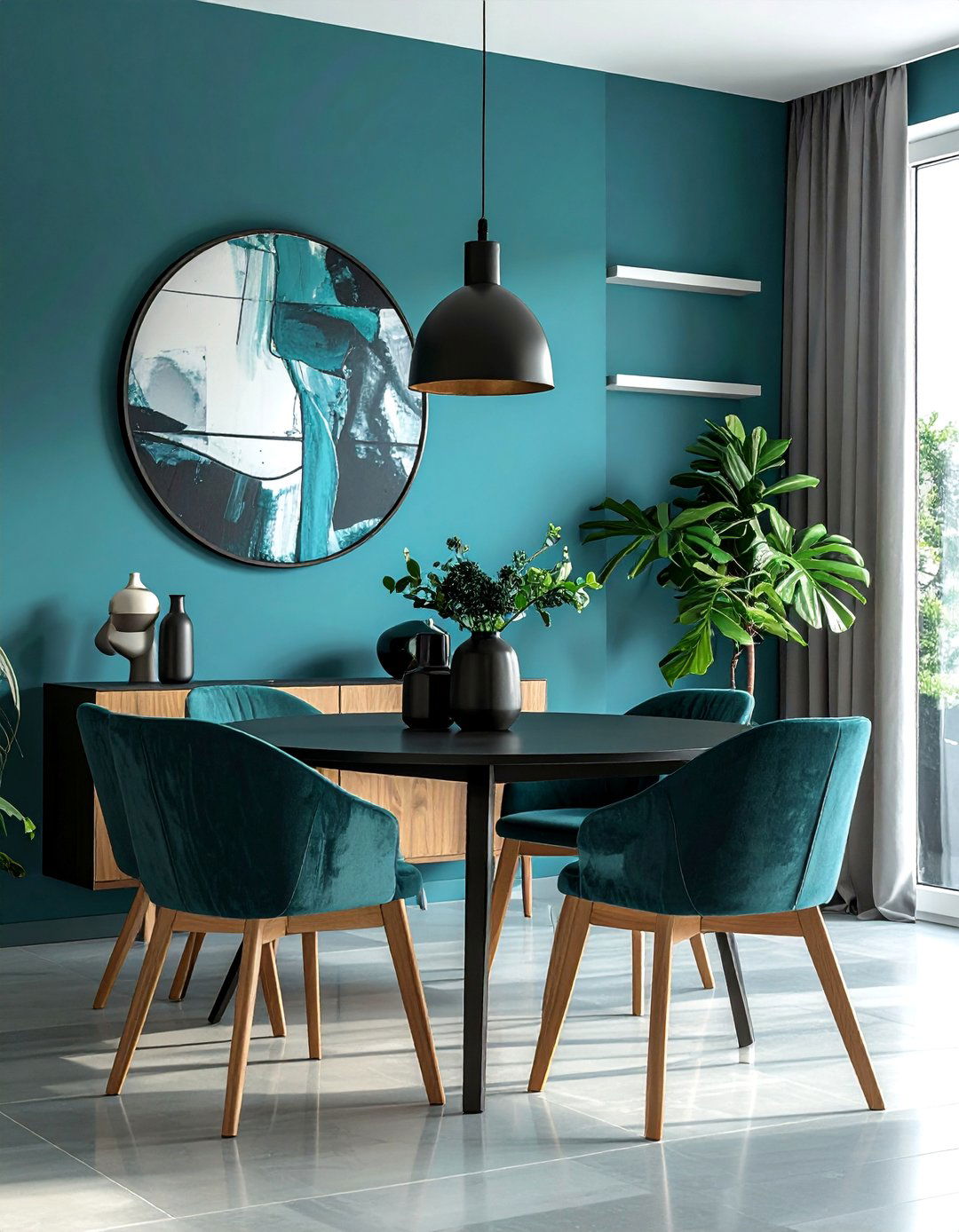
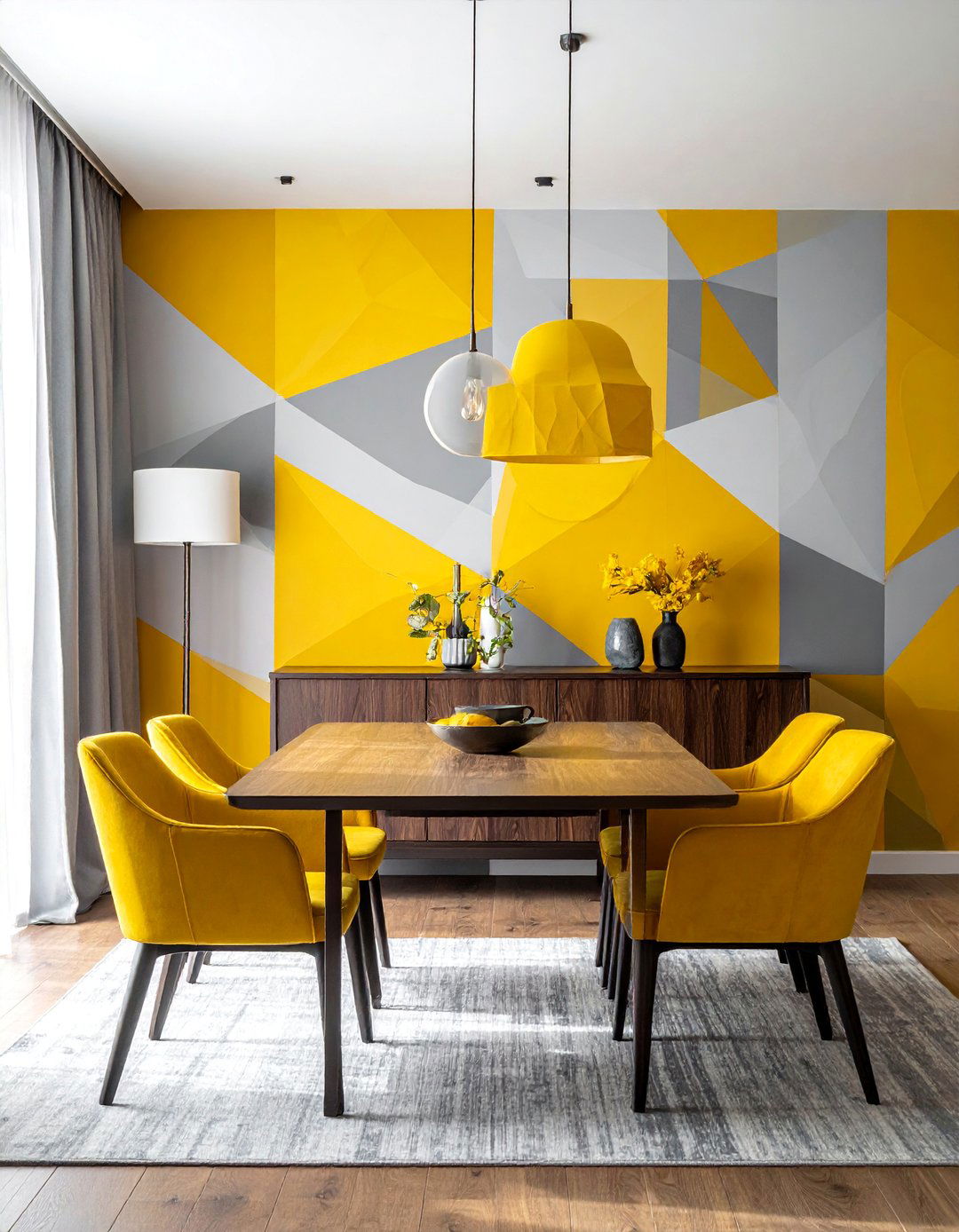
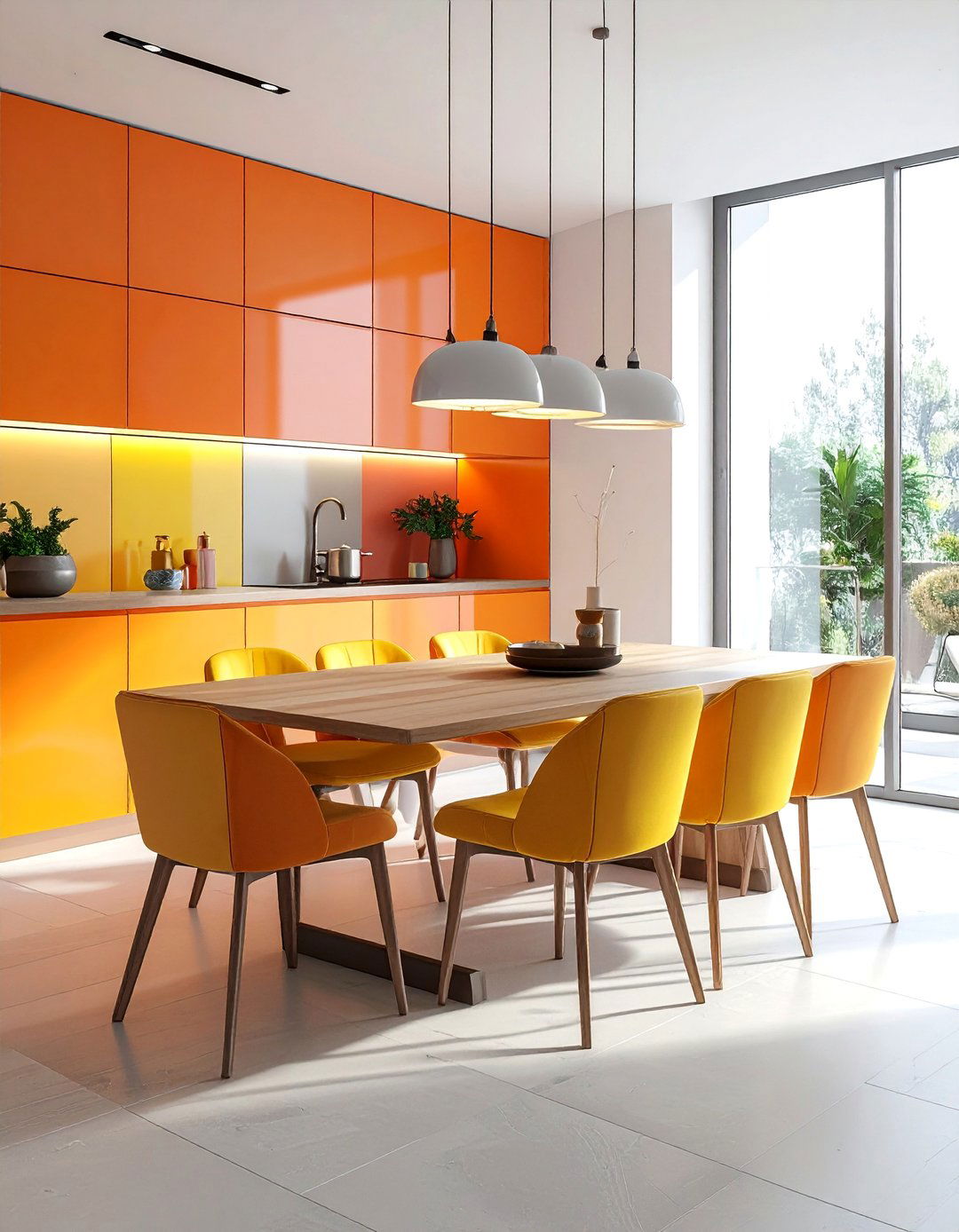
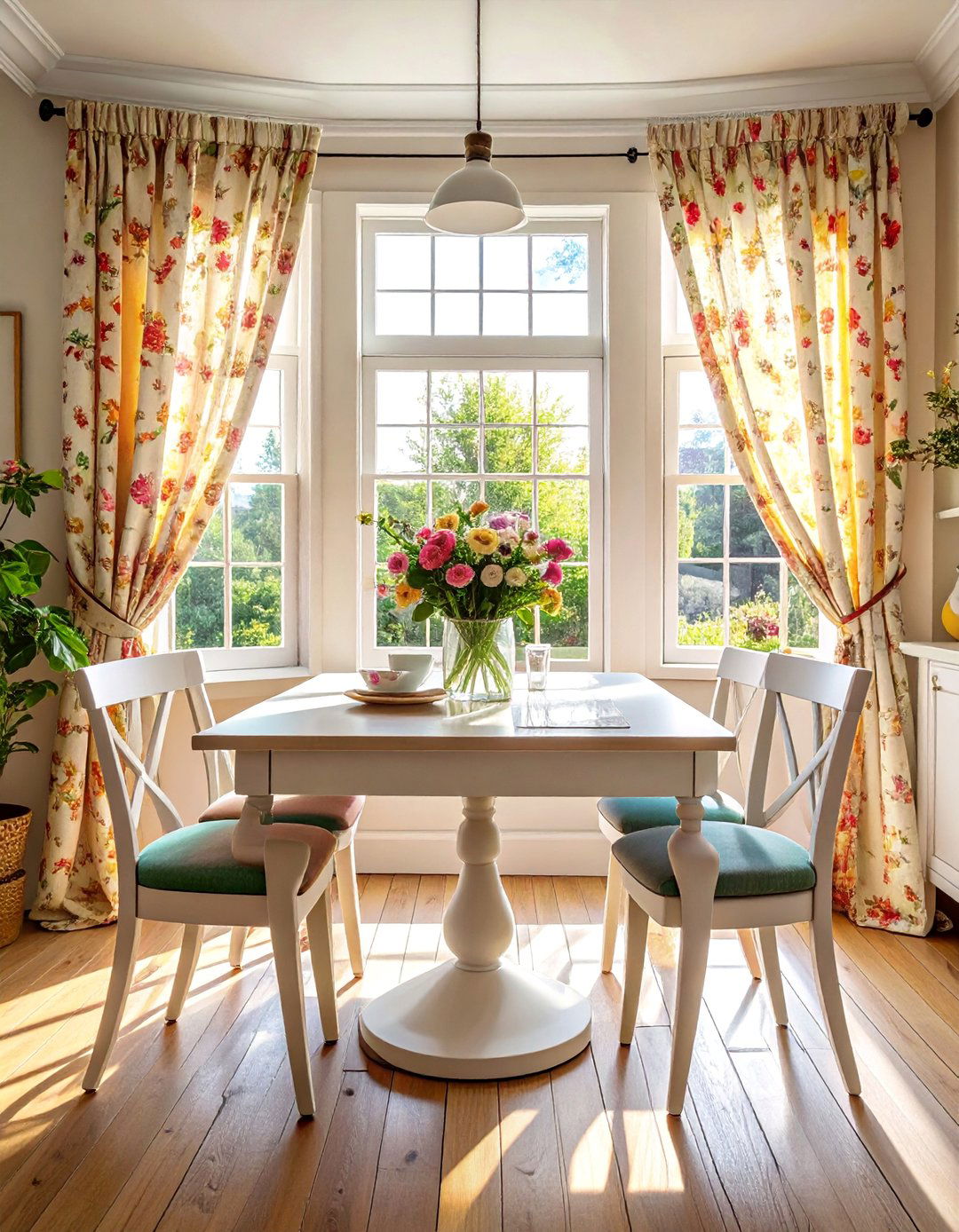
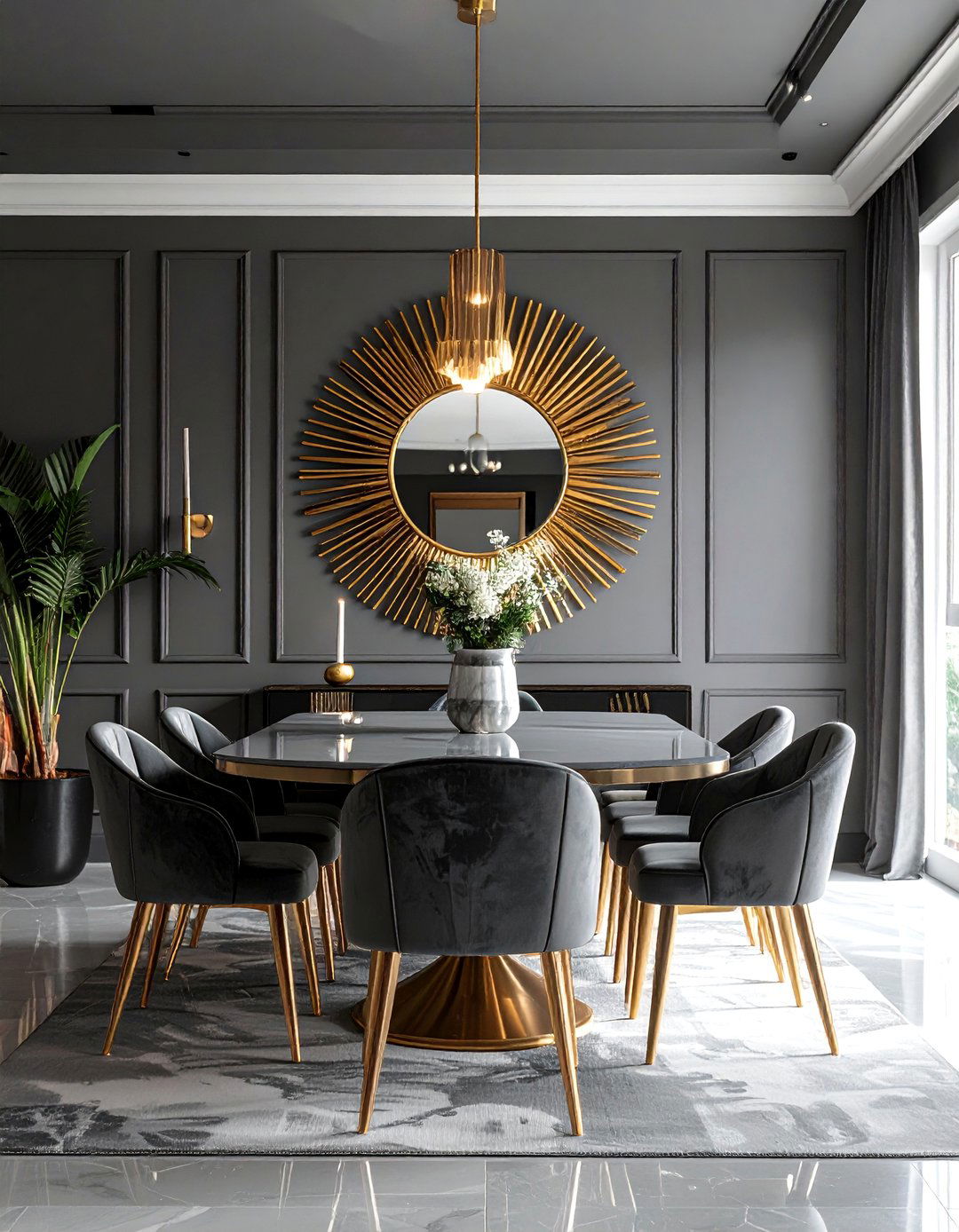
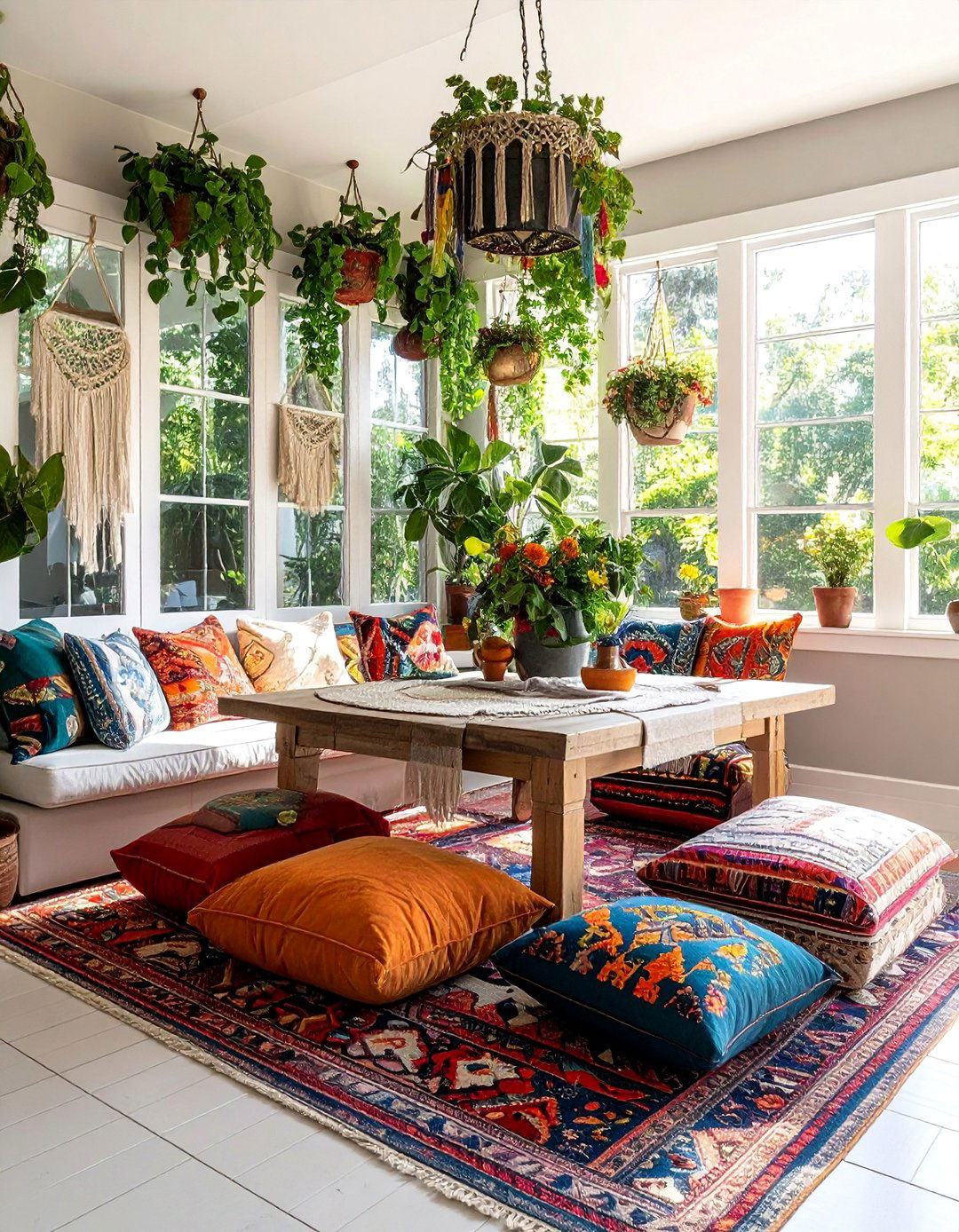
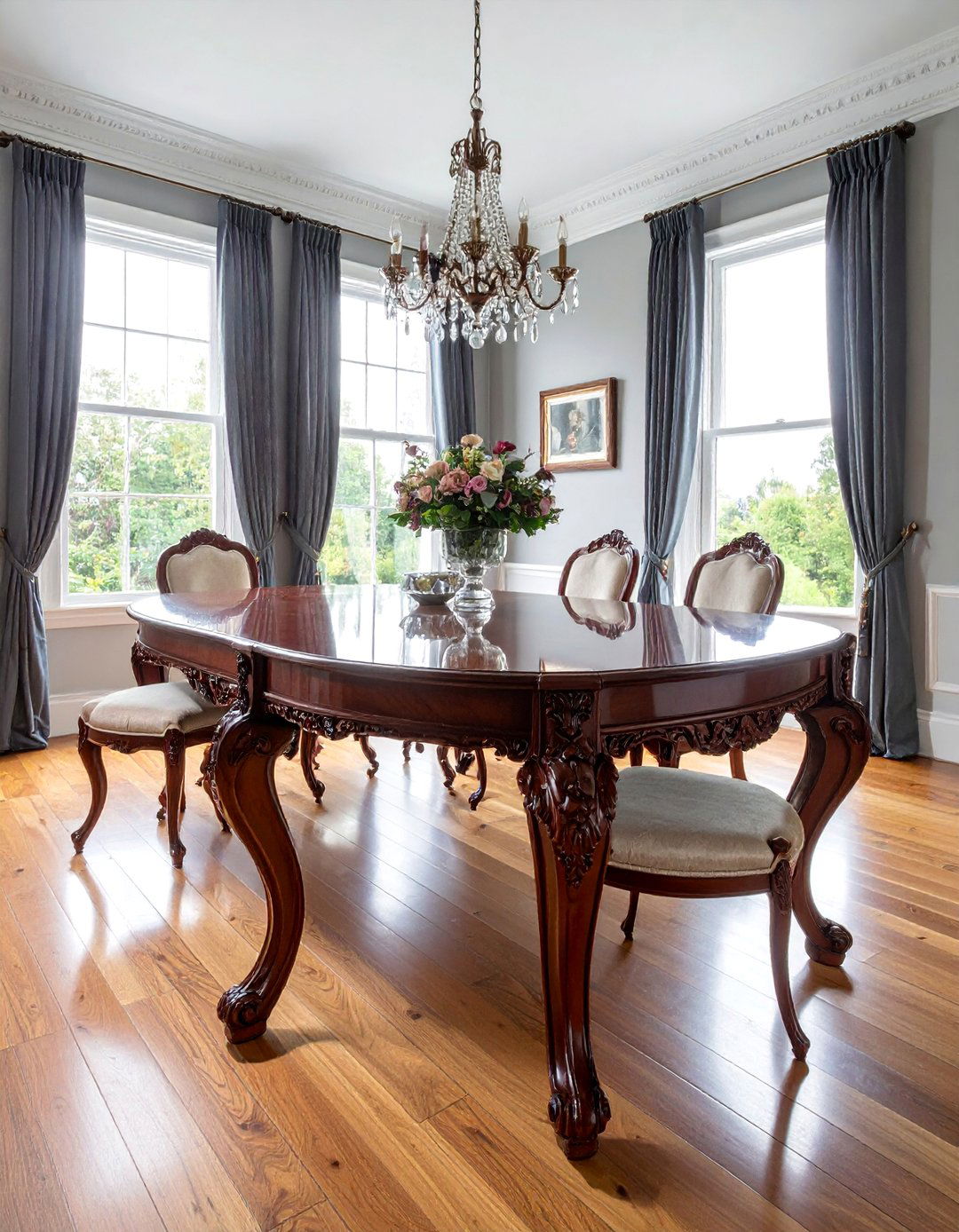
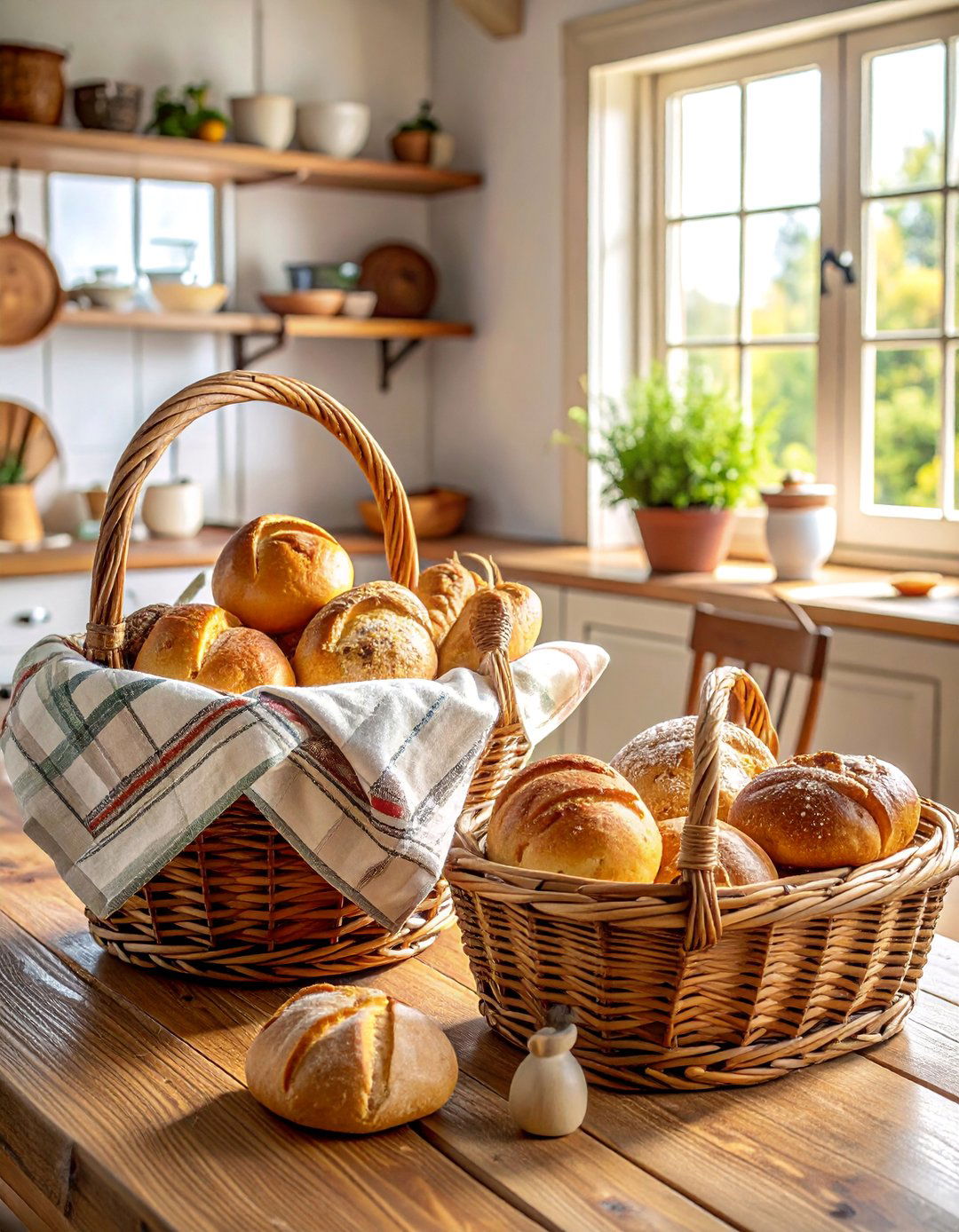
Leave a Reply